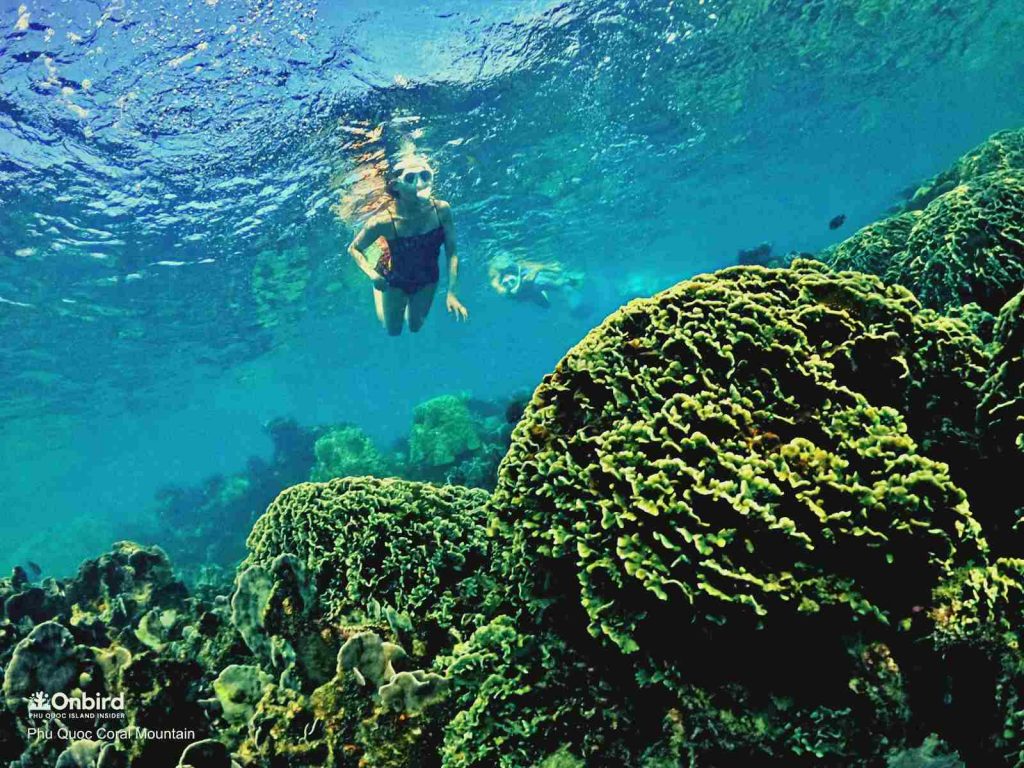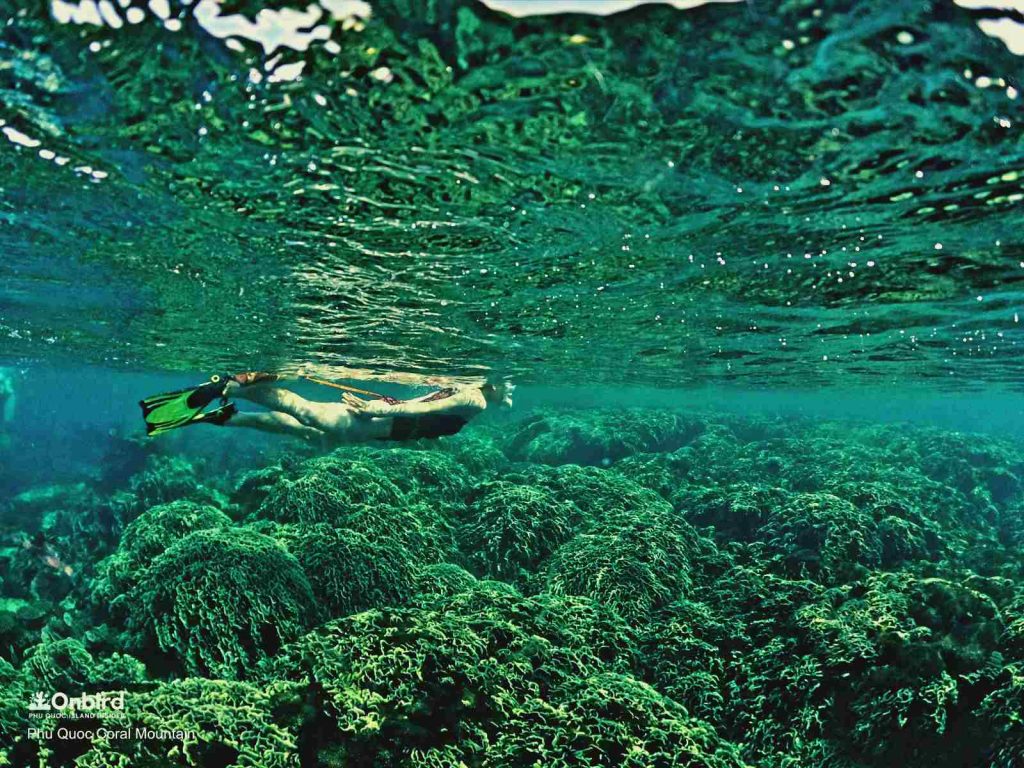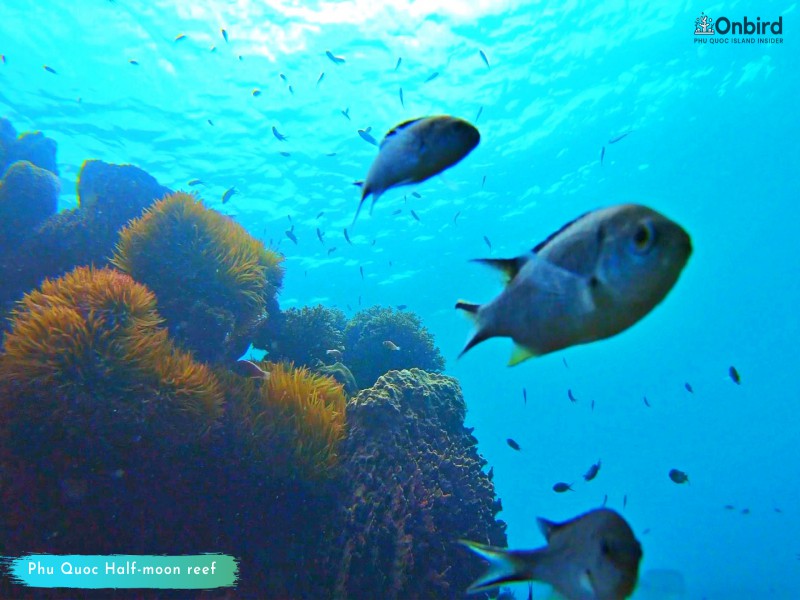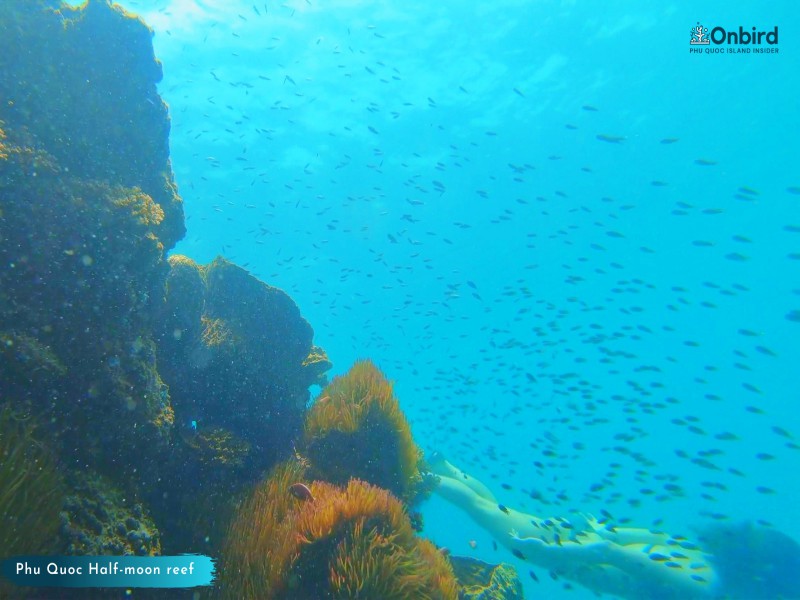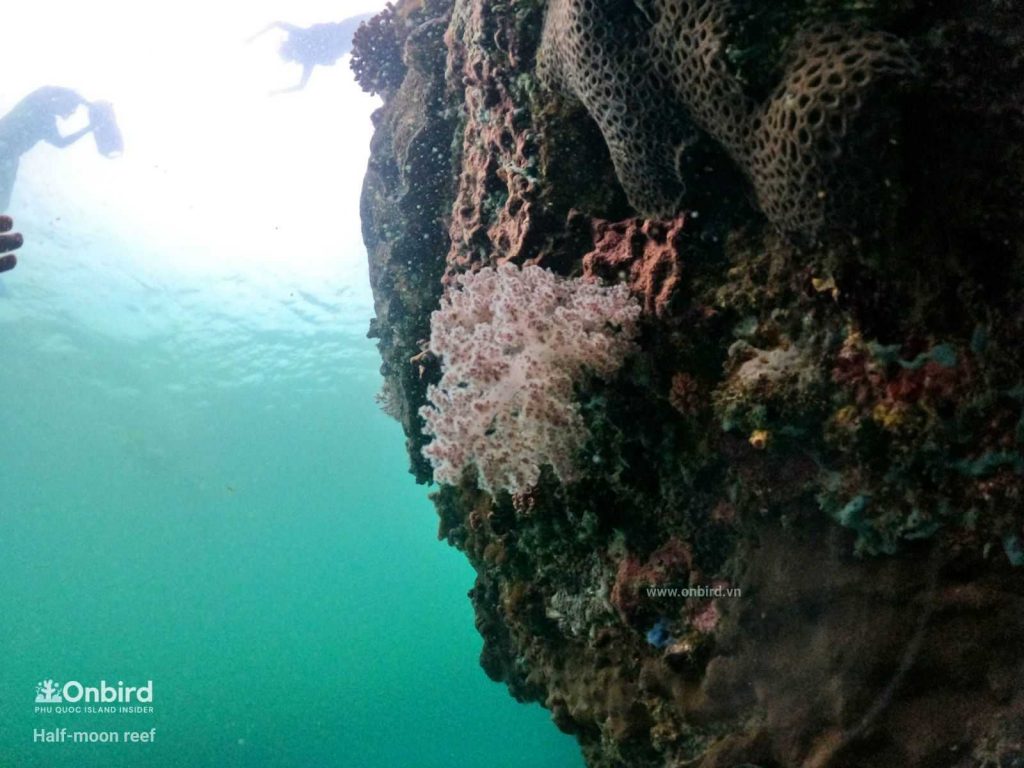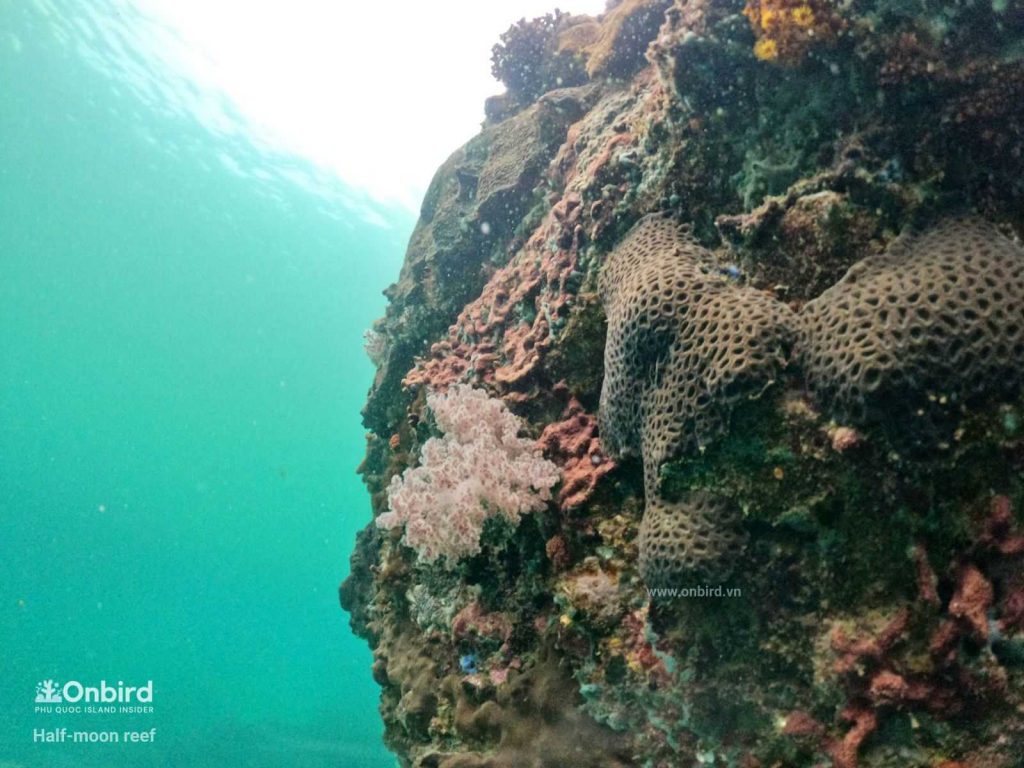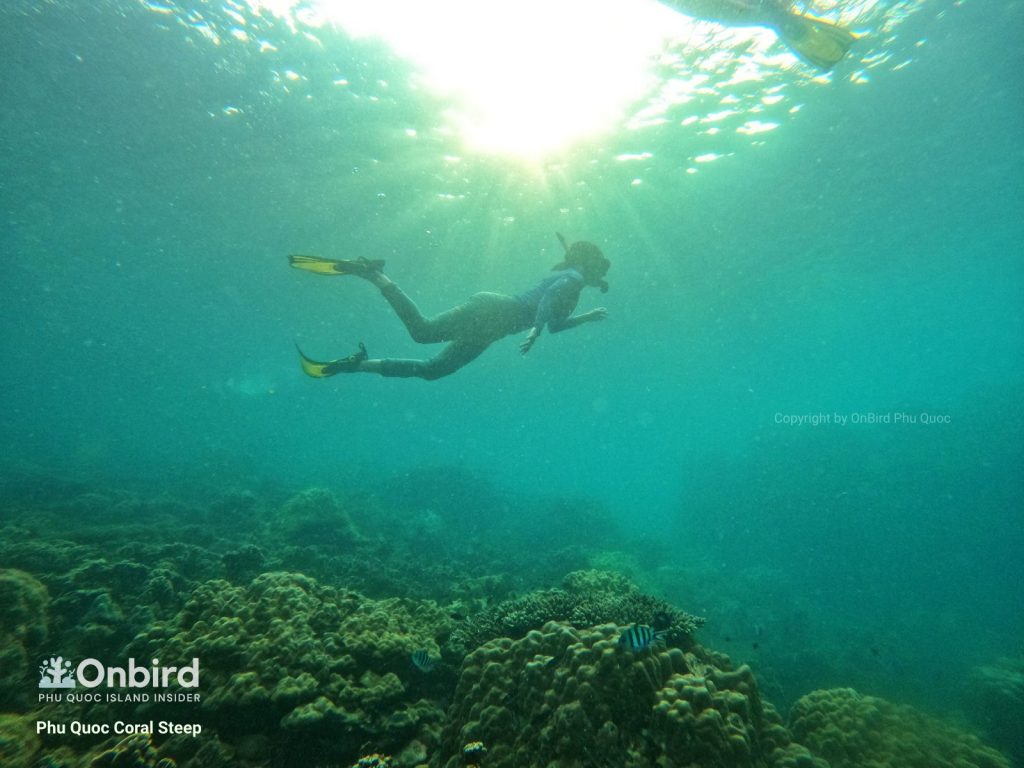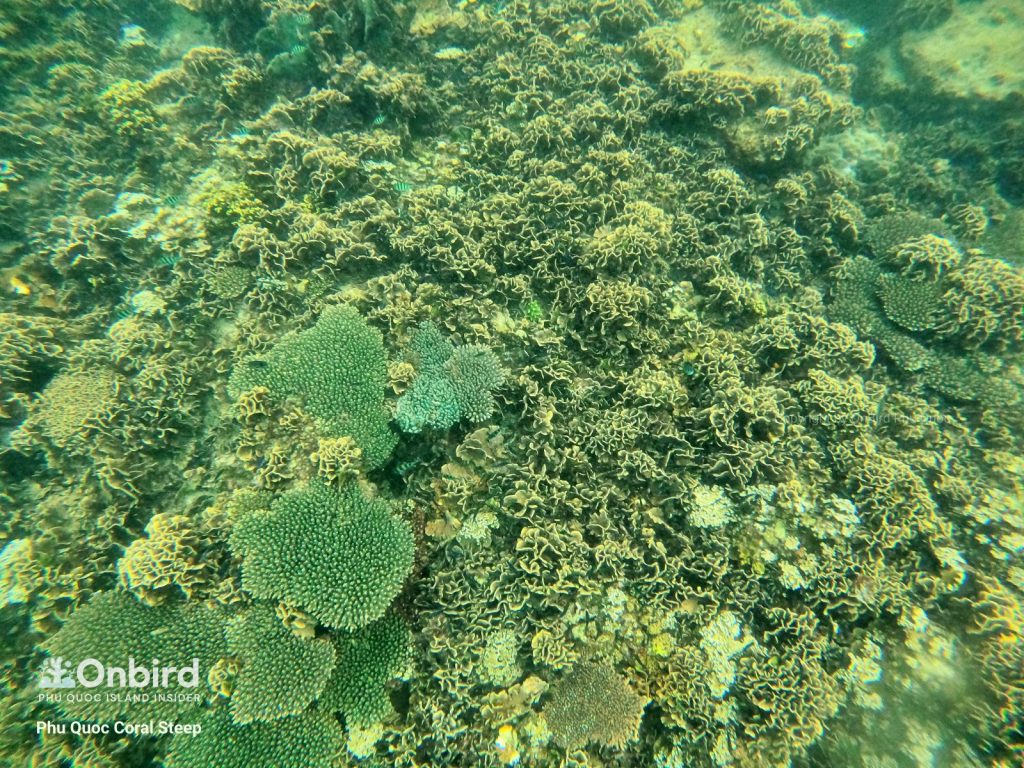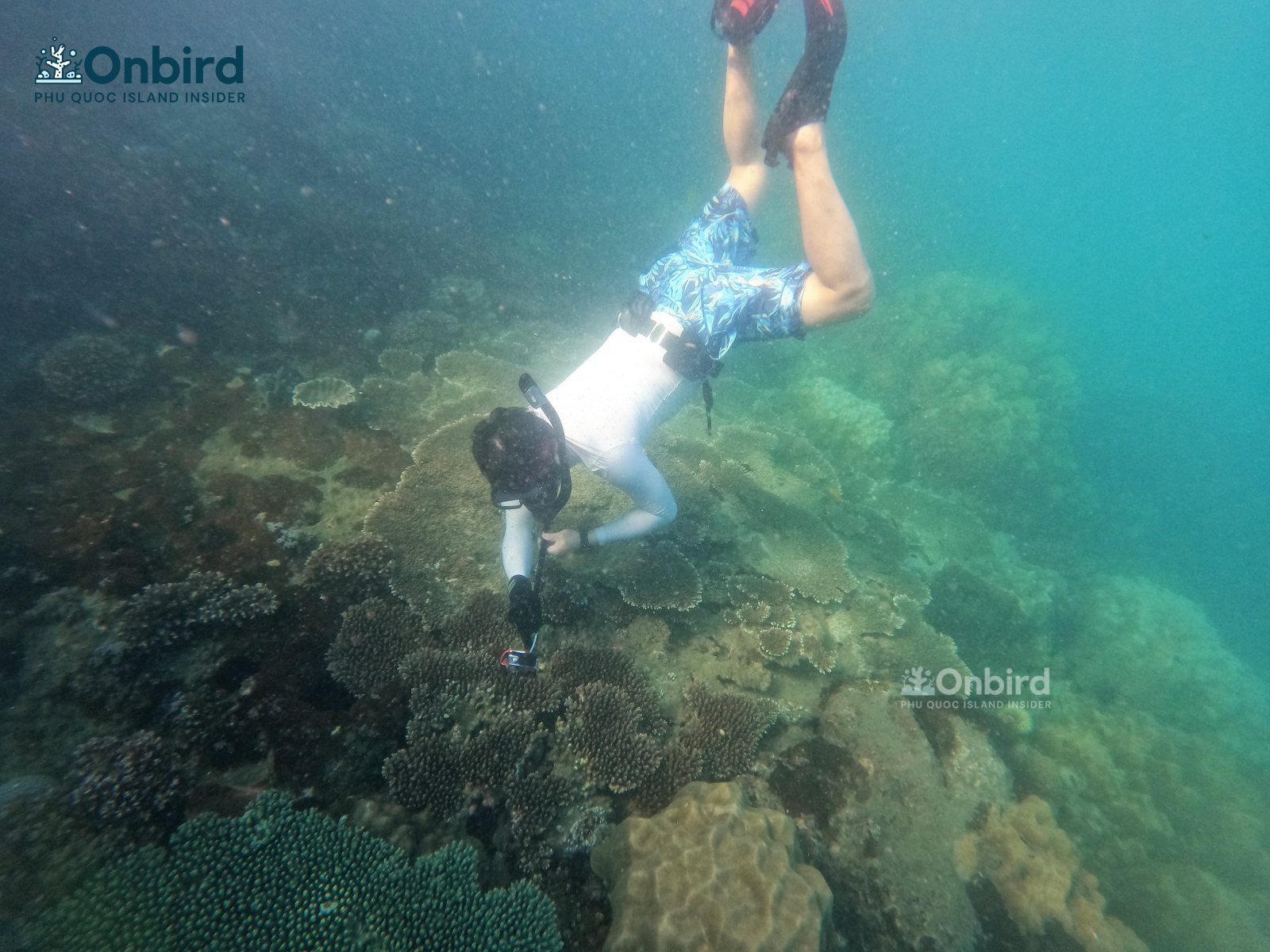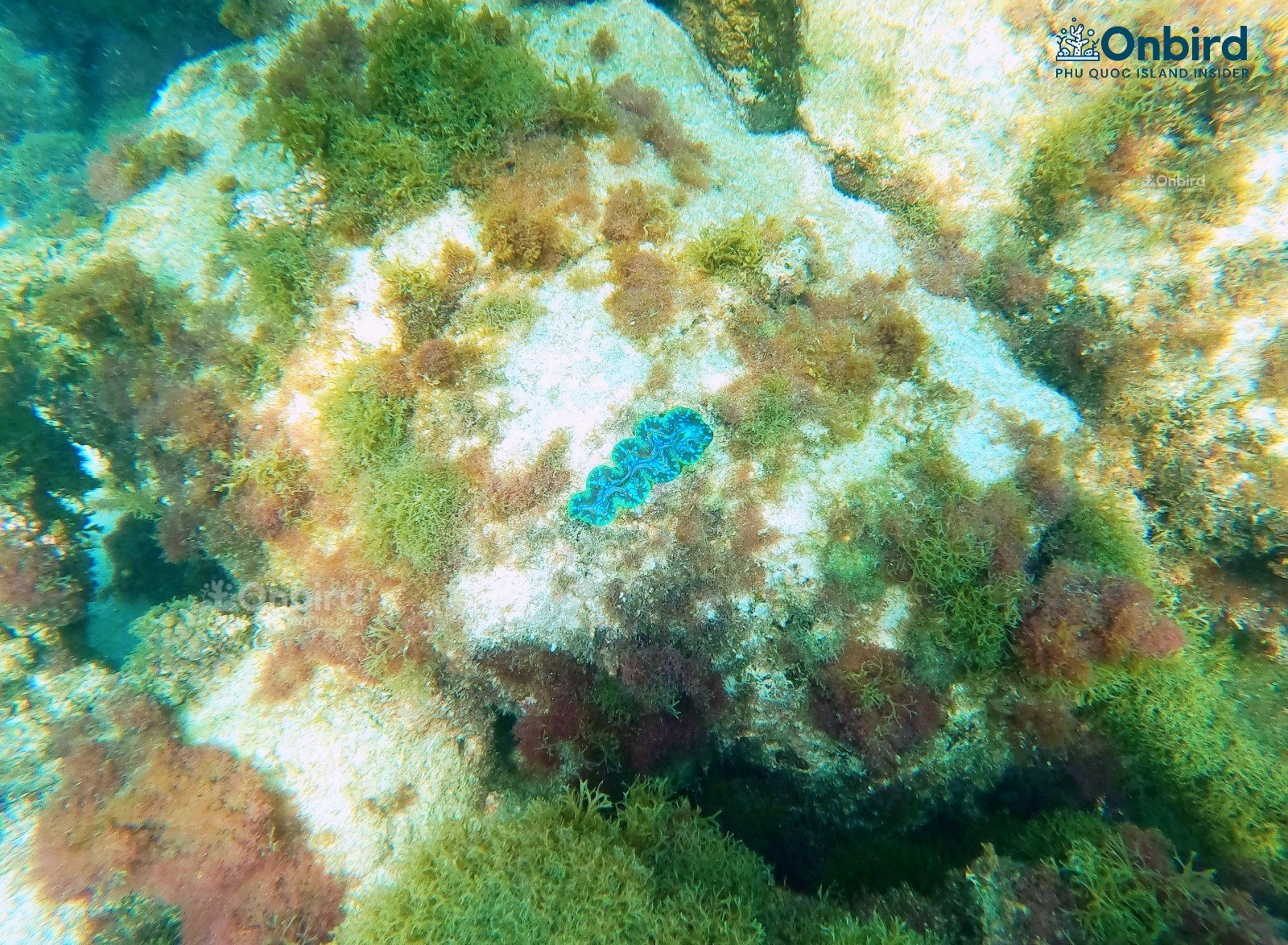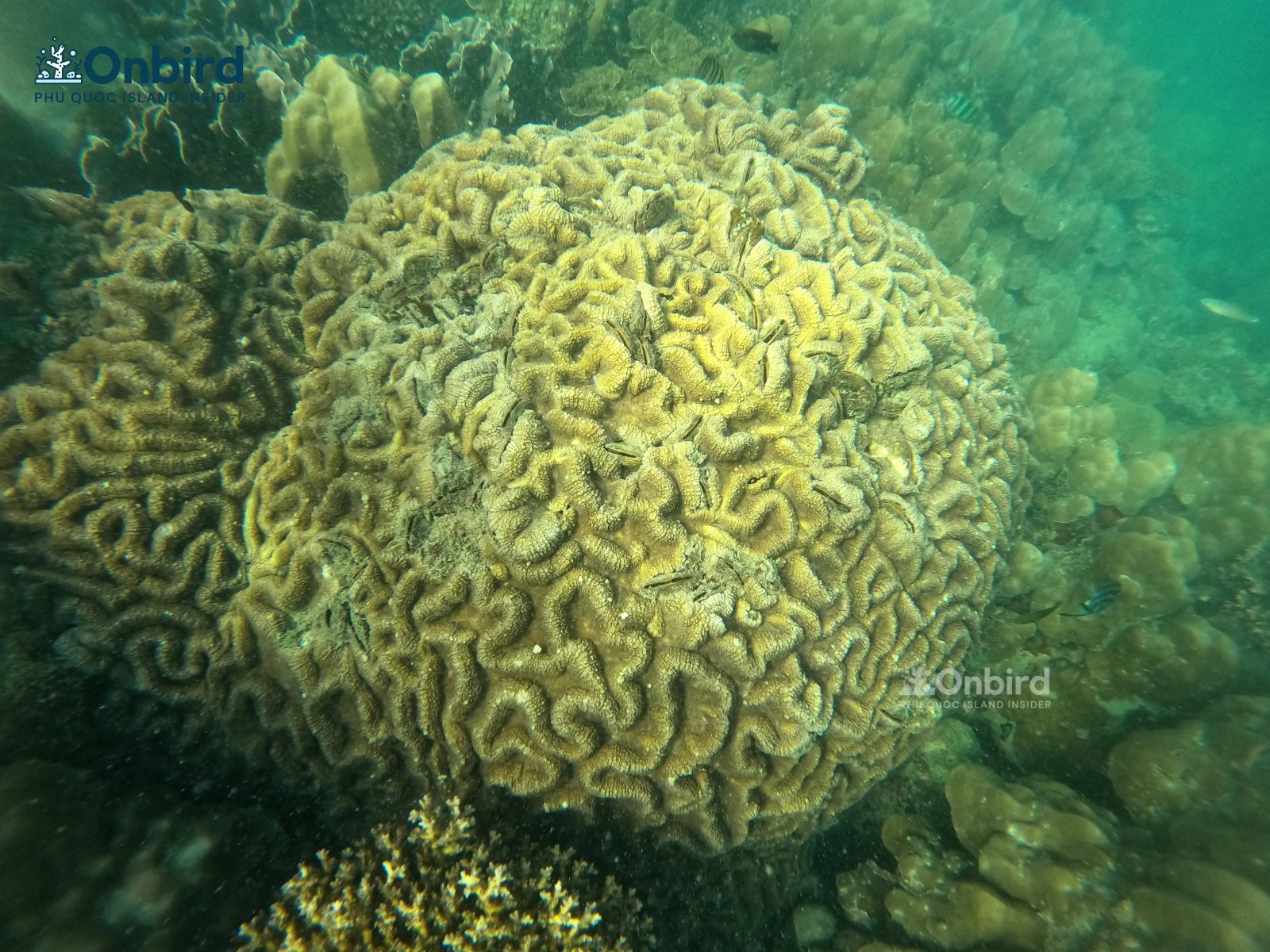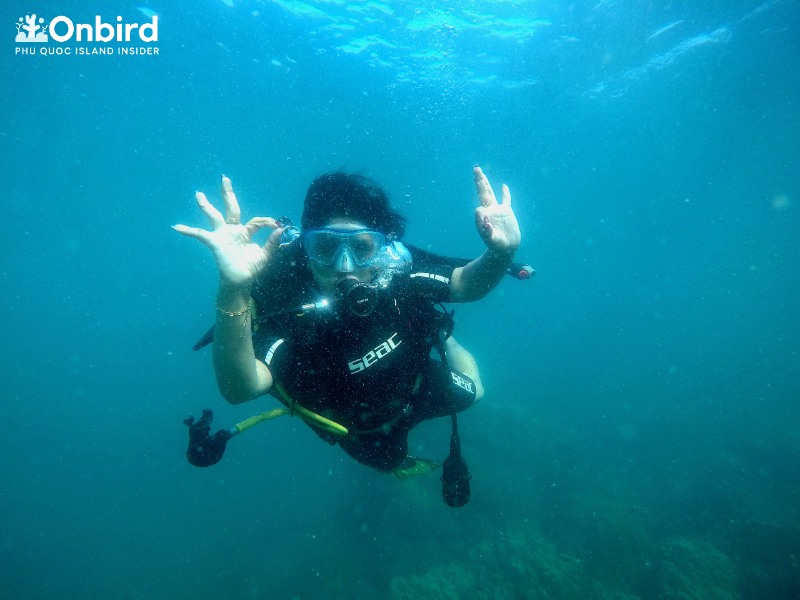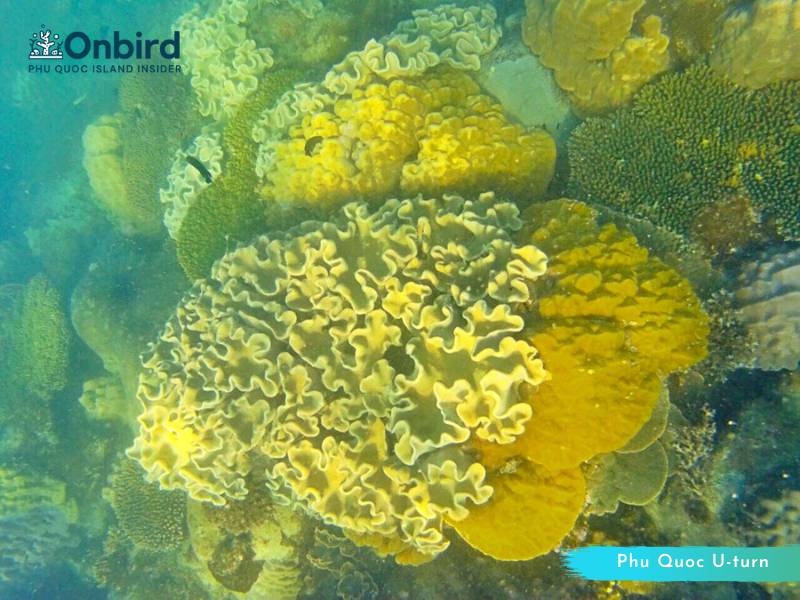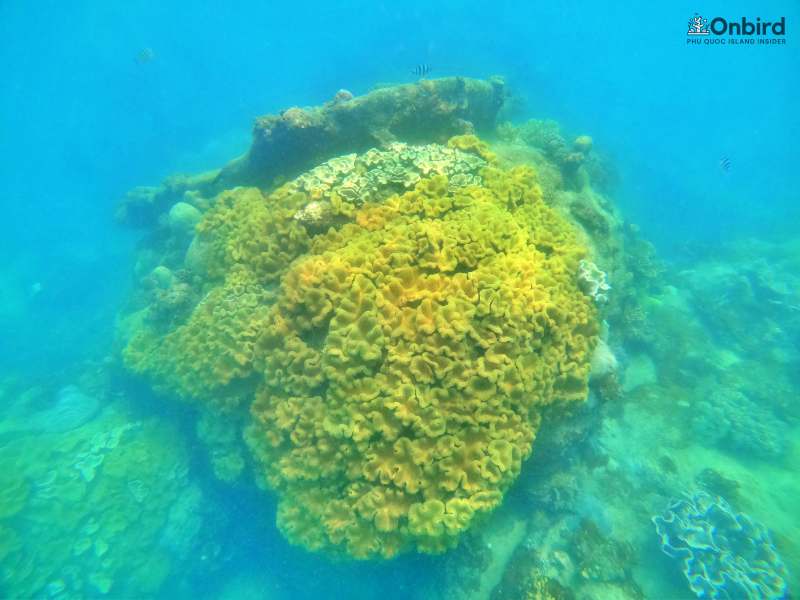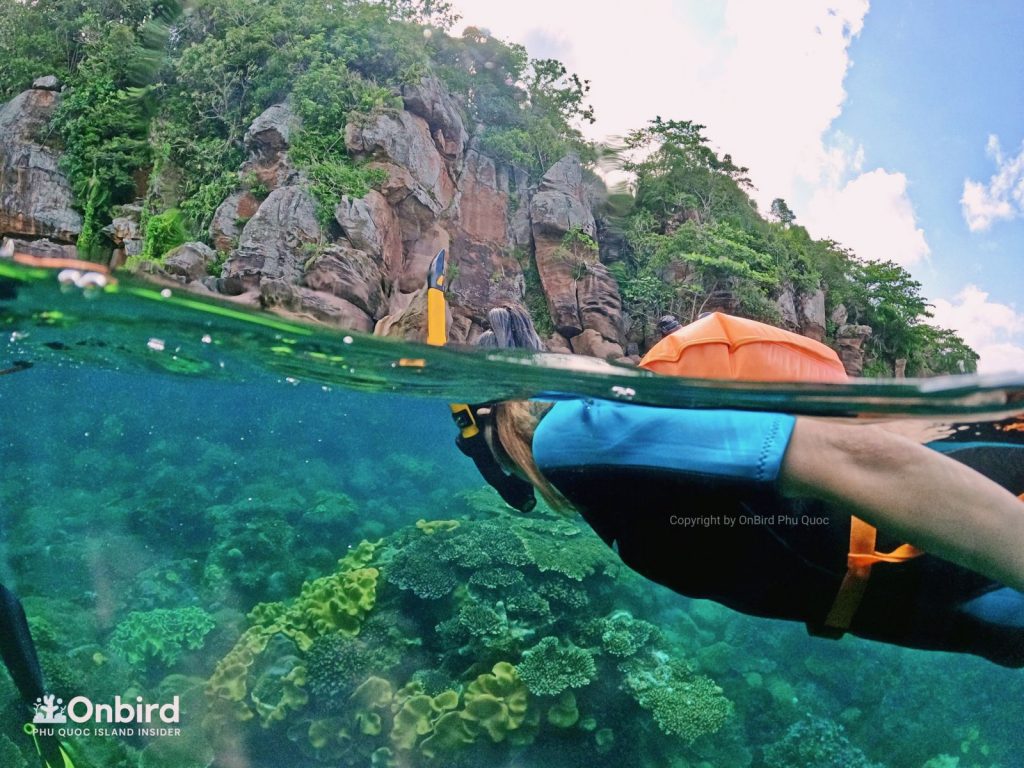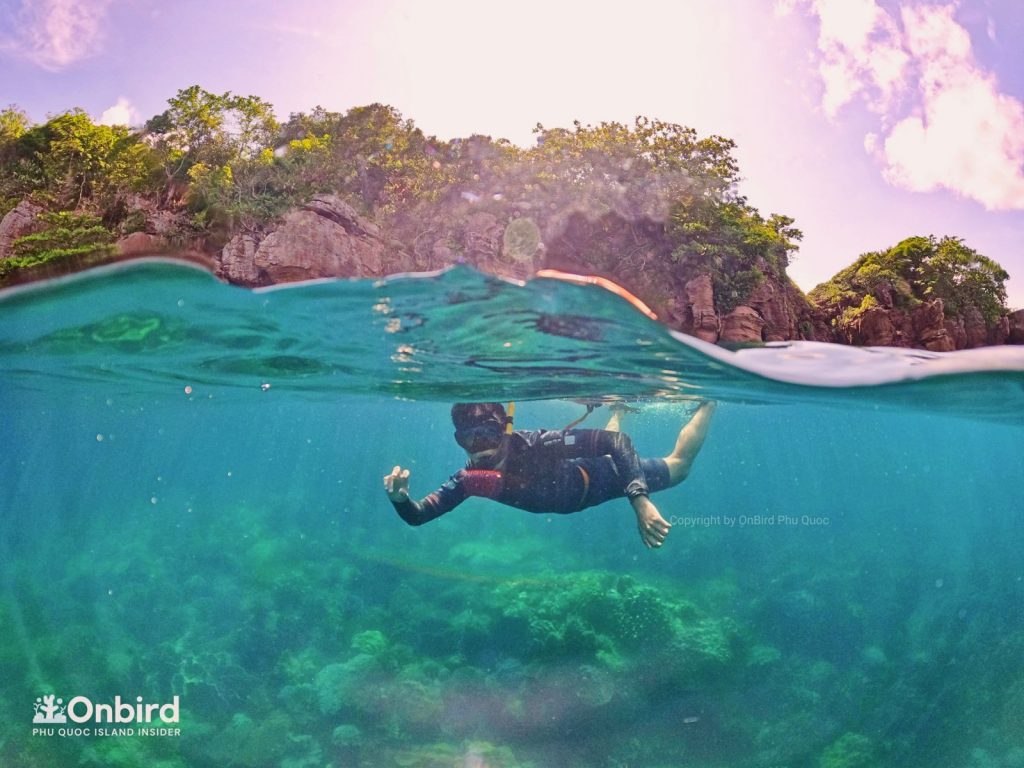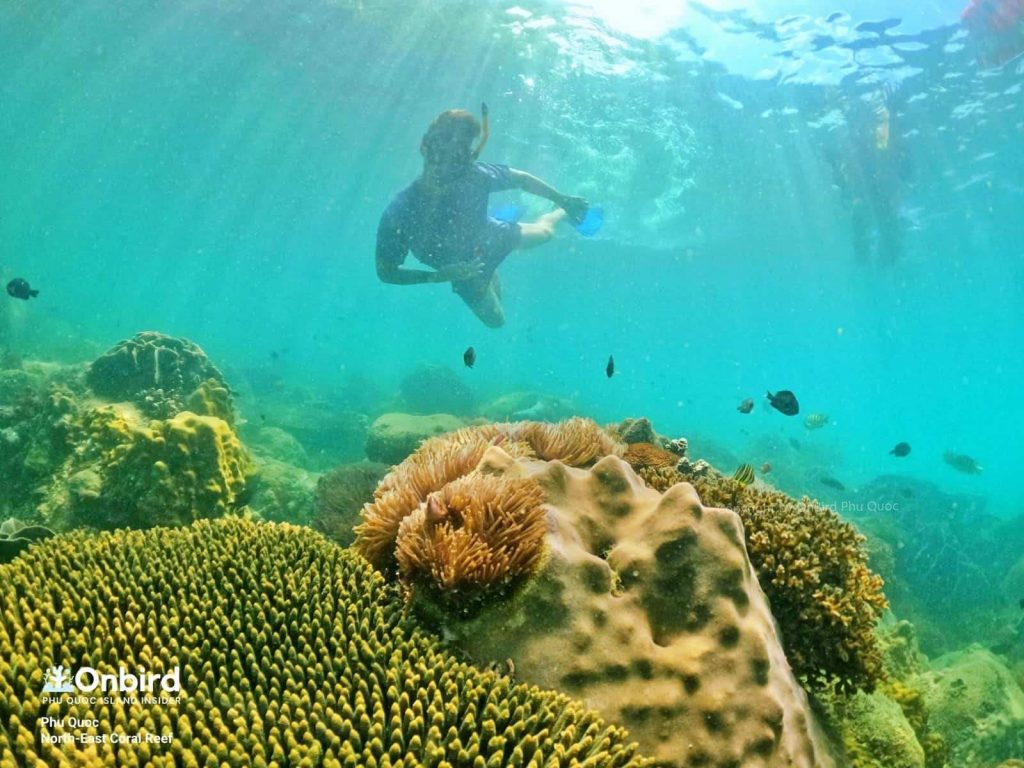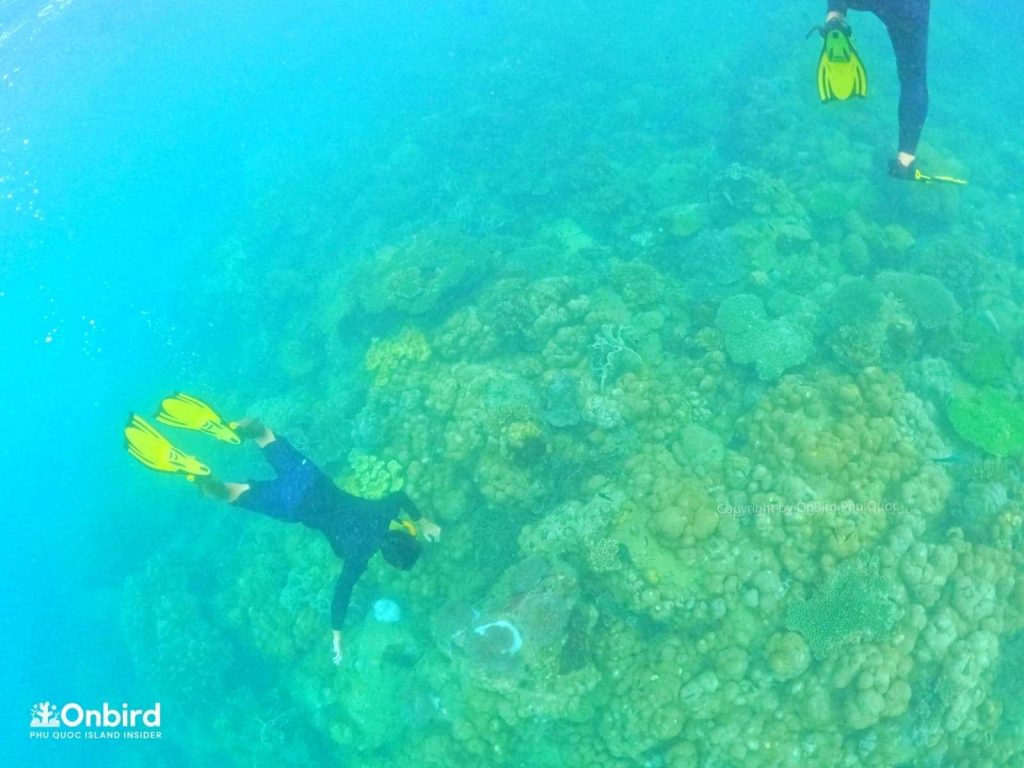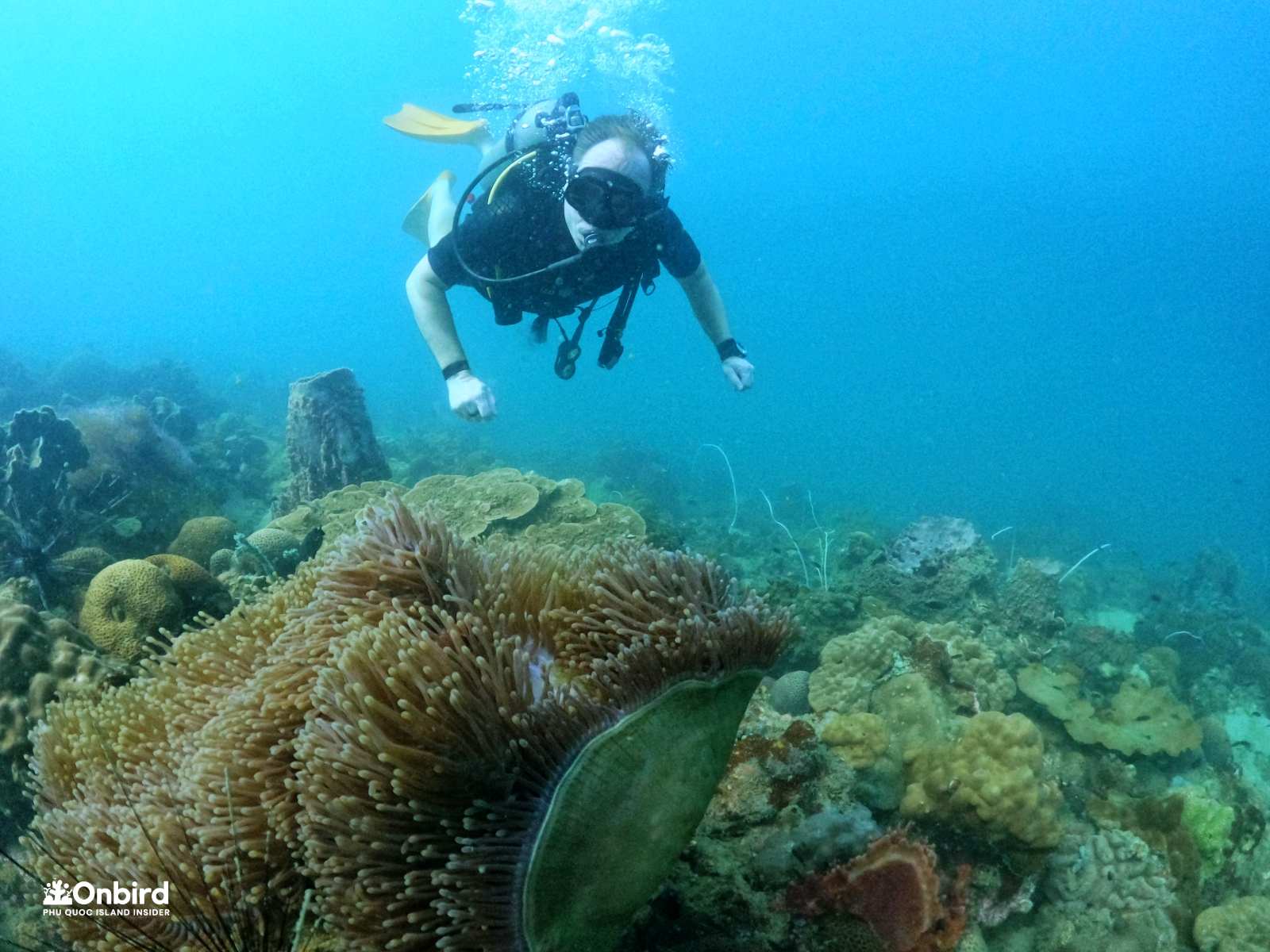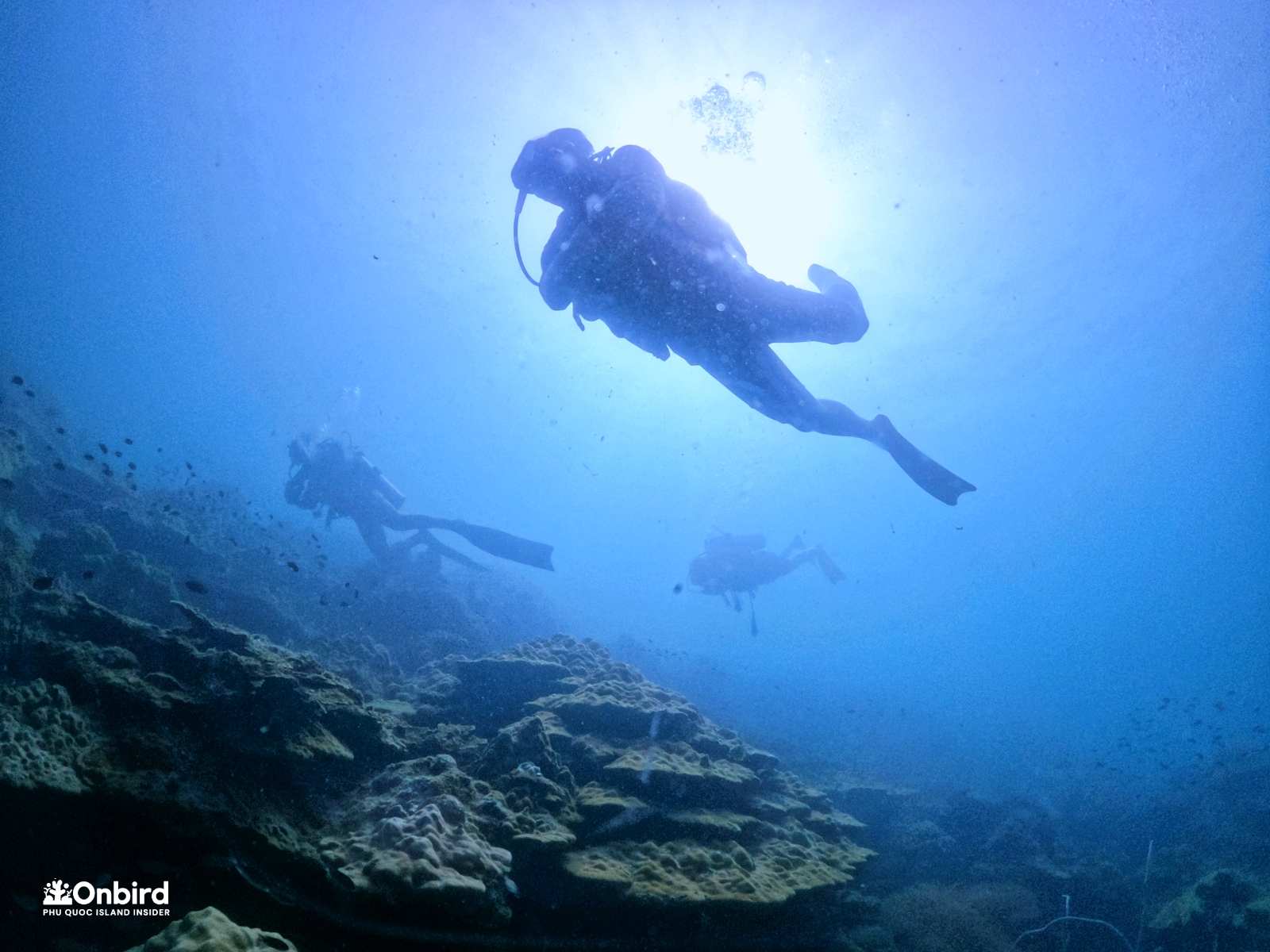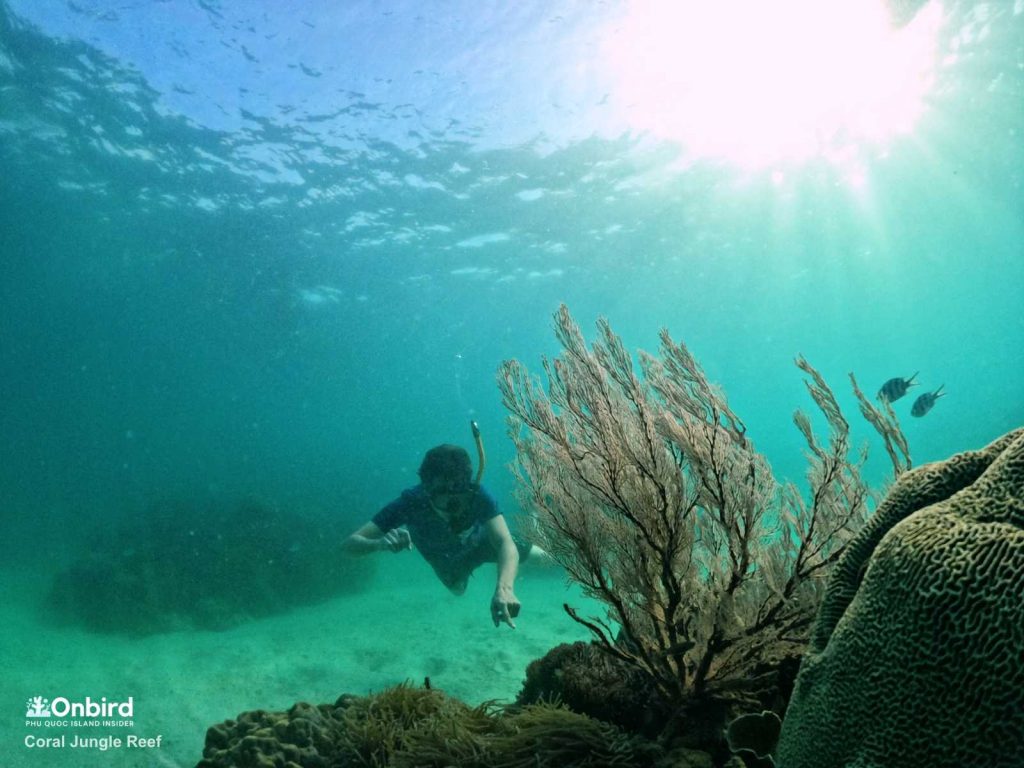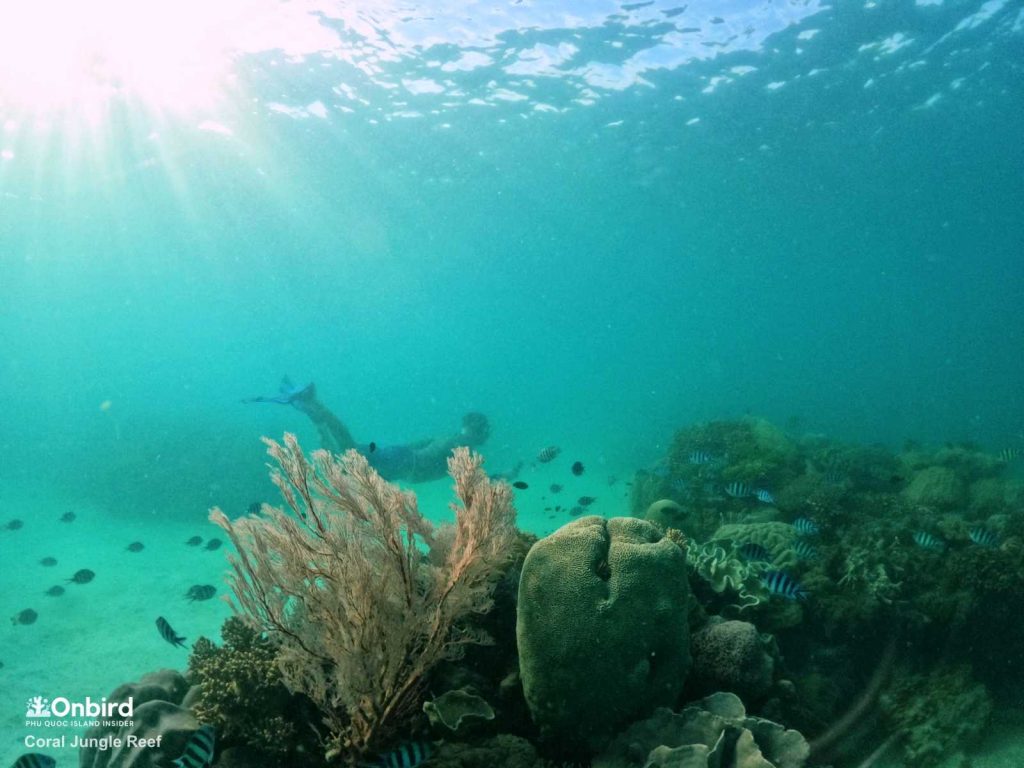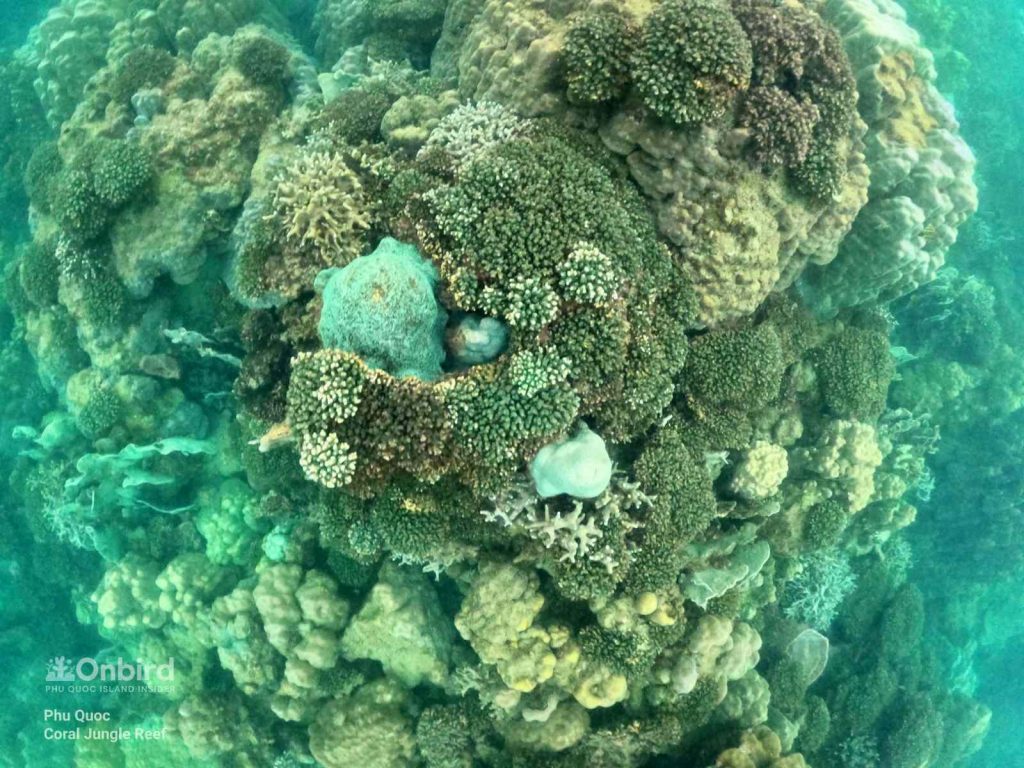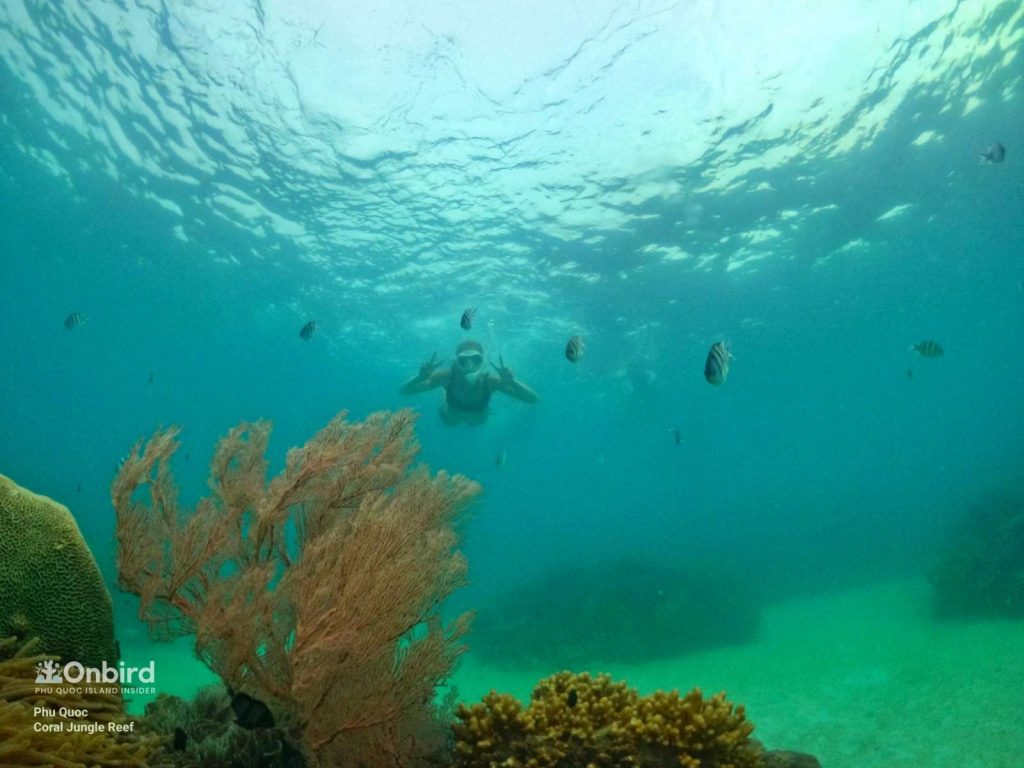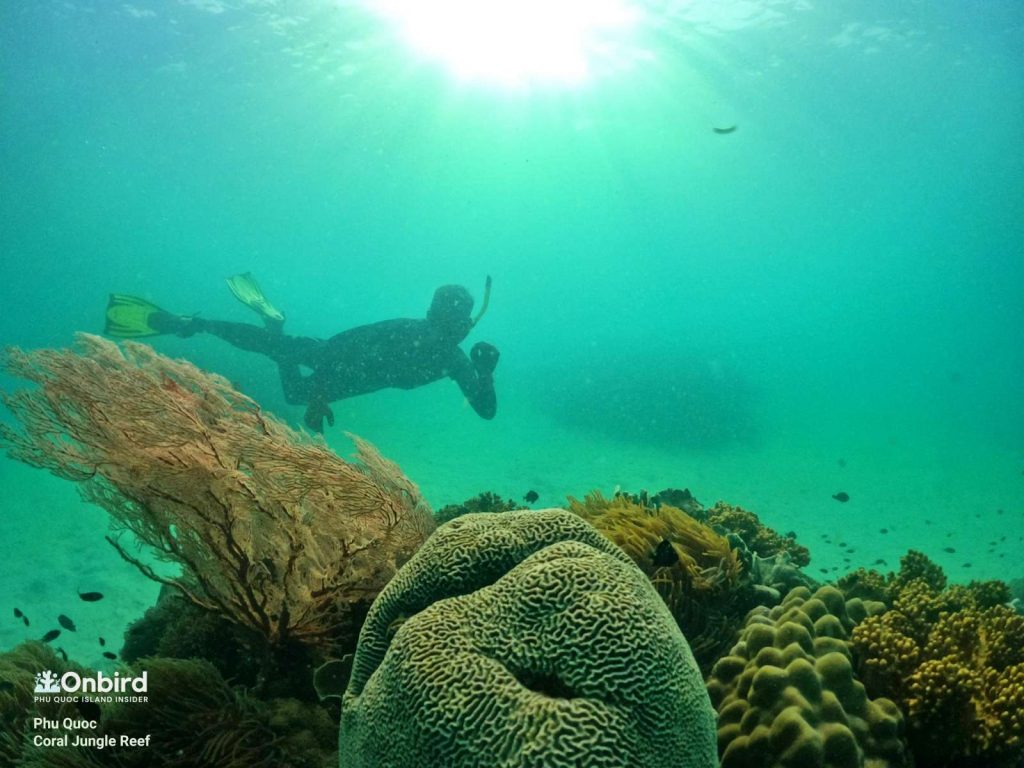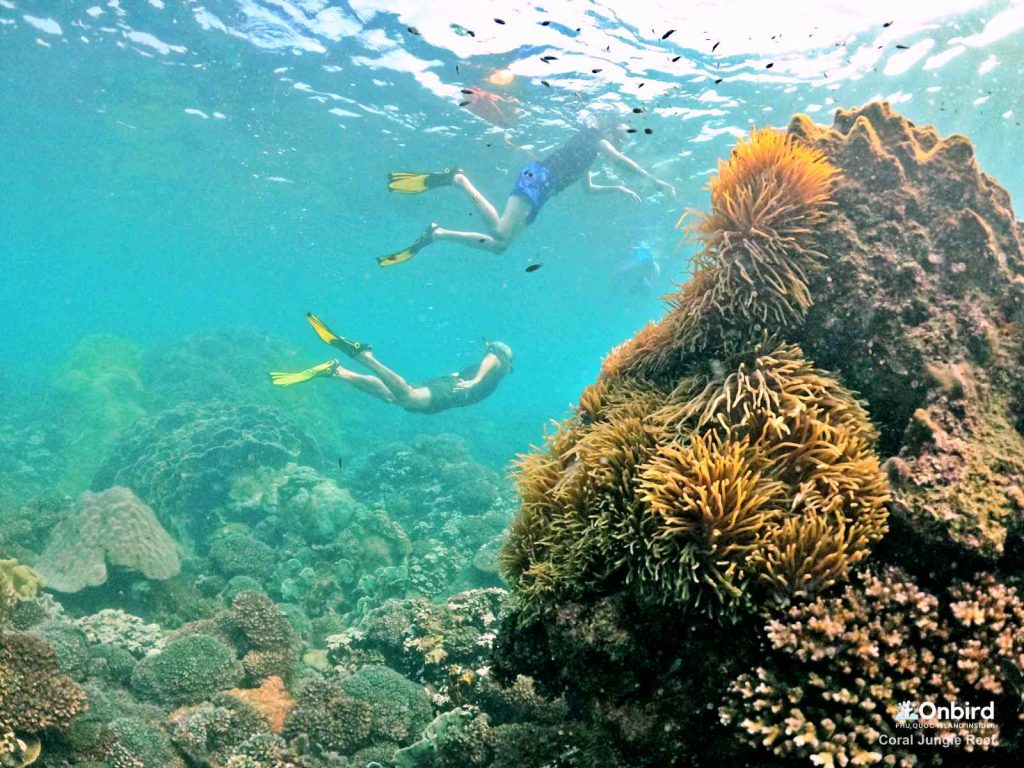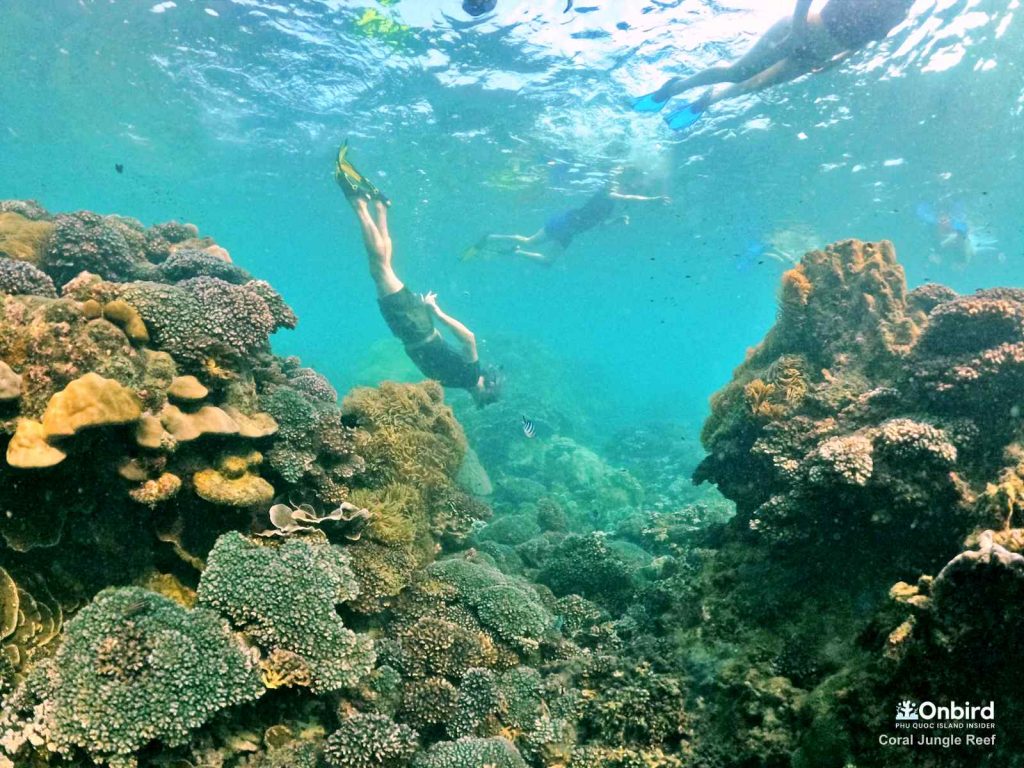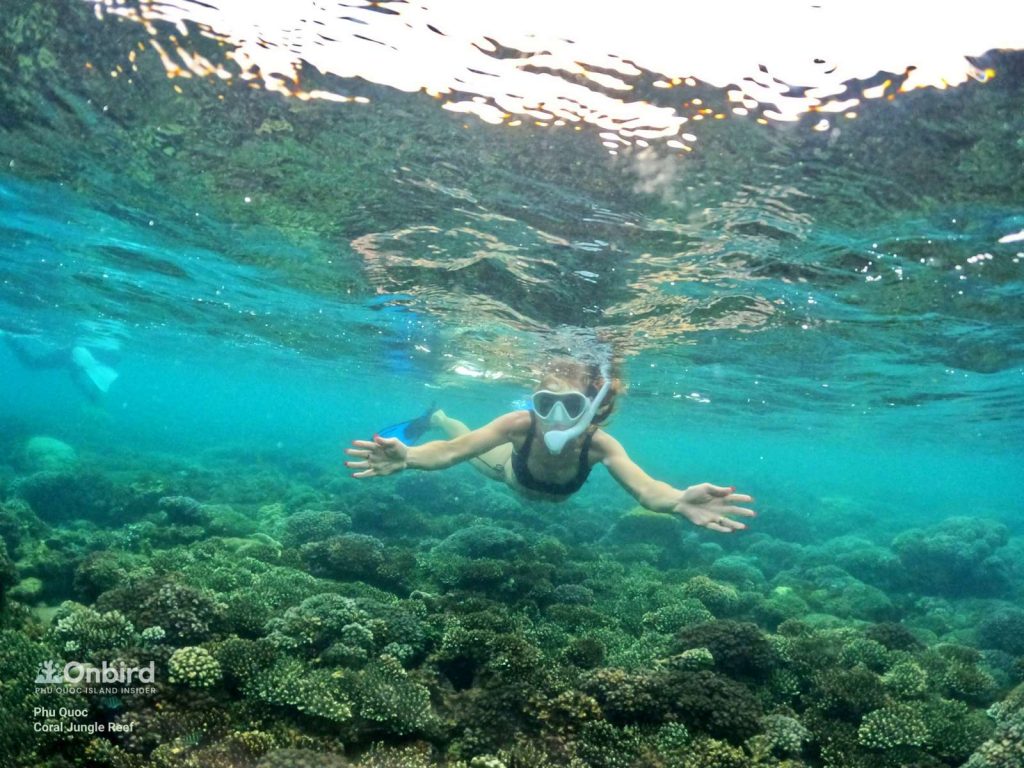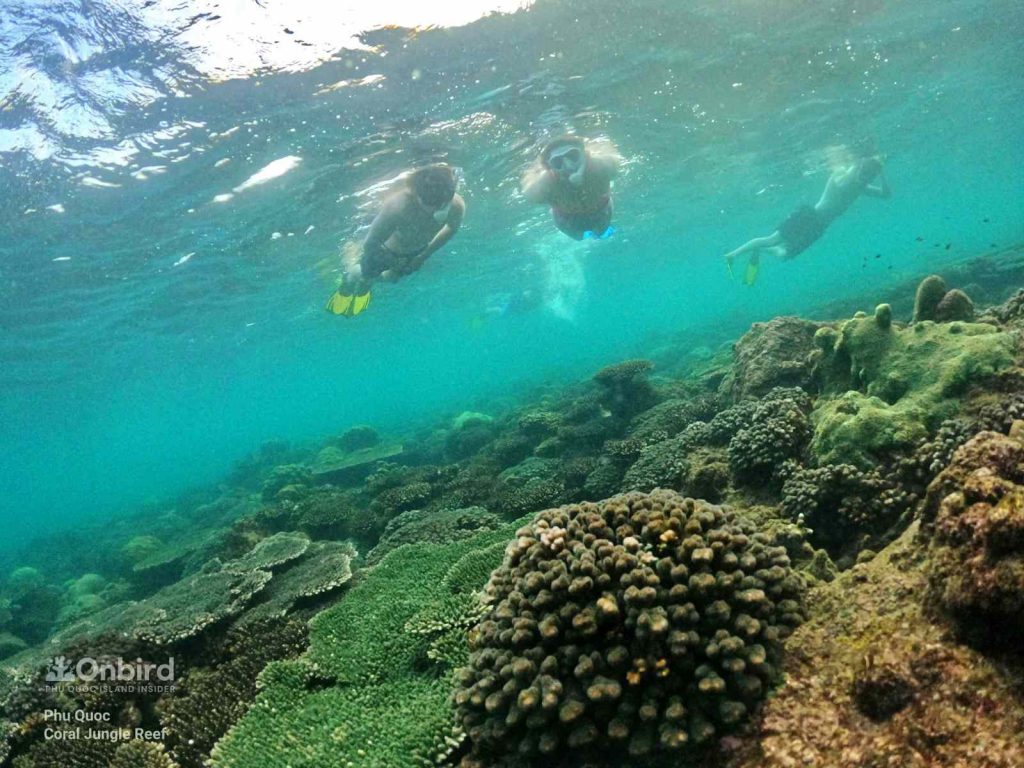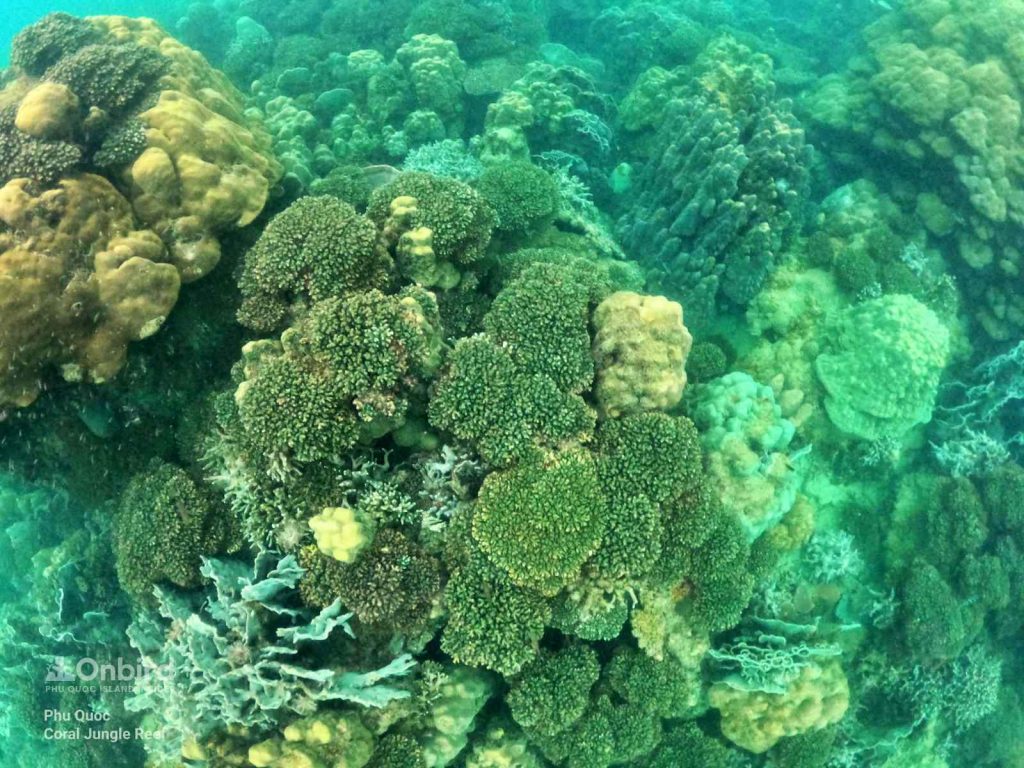Các lần cập nhật bài viết bởi OnBird:
- 30/12/2021
- 03/03/2022
- 13/07/2022
- 15/12/2022
- 05/02/2023
- 01/03/2023
- 18/03/2023
- 26/09/2023
Để hiểu rõ hơn về san hô và sinh vật tại vùng biển Phú Quốc nhằm mục đích trở thành Chuyên Gia Nước và nhà tổ chức trải nghiệm khám phá san hô, hệ sinh thái biển chuyên sâu gắn với các tiêu chuẩn du lịch bền vững, bảo vệ môi trường biển, ít tác động đến rạn san hô, OnBird Phú Quốc (thương hiệu thuộc sở hữu của cho CÔNG TY TNHH THƯƠNG MẠI VÀ DỊCH VỤ DU LỊCH NÚI SAN HÔ) là công ty đầu tiên và tiên phong tại Phú Quốc xây dựng và thu thập dữ liệu về rạn san hô, loài san hô, mật độ phân bố, tình trạng sức khỏe san hô và điều kiện nước tại Phú Quốc, Việt Nam.
Chúng tôi bắt đầu thu thập và phát triển thông tin về các rạn san hô ở Phú Quốc từ năm 2018, dựa trên các thông tin, tư liệu thu thập được để xây dựng các hoạt động & trải nghiệm thiên về khám phá sinh vật biển (Lặn ống thở chuyên nghiệp và Lặn bình dưỡng khí chuyên nghiệp). OnBird xây dựng hiểu biết về đặc điểm rạn san hô ở Phú Quốc cũng như theo dõi sự thay đổi các rạn san hô ở tại đây qua thời gian trong bối cảnh chúng ta đang chứng kiến sự suy thoái nhanh chóng của san hô ở Phú Quốc và Việt Nam nói chung dưới tác động của con người, du lịch thiếu bền vững hoặc đánh bắt cá trái phép.
Hoạt động gỡ lưới ma, tái trồng san hô gãy tại đảo Phú Quốc do OnBird thực hiện.
Phú Quốc, hòn đảo lớn nhất Việt Nam nằm gần đường xích đạo, với đặc điểm thời tiết khí hậu nhiệt đới gió mùa rõ rệt, là một trong những môi trường biển hàng đầu Việt Nam cho các rạn san hô phát triển thuận lợi, mạnh mẽ và đa dạng. Dựa trên các quan sát, theo dõi thực tế trong các chuyến lặn biển, khảo sát, OnBird đánh giá và đưa ra danh sách các rạn san hô đẹp nhất tại vùng biển Phú Quốc (cập nhật tới tháng 8 năm 2022) thích hợp cho lặn biển. Chúng tôi sử dụng các tên gọi riêng cũng như không đưa rõ vị trí cụ thể của mỗi Rạn san hô nhằm tránh việc xâm hại, hạn chế việc khai thác du lịch thiếu trách gây tổn hại tới các rạn san hô, một thực trạng đáng báo động đang xảy ra tại Phú Quốc những năm gần đây do sự phát triển mạnh của hoạt động du lịch. Đảo Phú Quốc có thể xem là nơi có những Rạn san hô hay độ đa dạng loài hàng đầu Việt Nam cùng với Nha Trang, Côn Đảo, Thổ Chu, quần đảo Hoàng Sa và Trường Sa…Phú Quốc là nhà của 260 loài san hô chiếm 32.5% tổng số lượng loài san hô trên thế giới (798 loài), trong đó gồm 252 loài san hô cứng và 8 loài san hô mềm thuộc 49 giống của 14 họ, các giống chiếm ưu thế là Porites, Acropora, Montipora, Pavona, Echinopora, Diploastrea. San hô Phú Quốc phân bố từ Bắc đến Nam đảo, với tổng diện tích là 473,9 ha, trong đó tập trung chủ yếu ở Nam Quần đảo An Thới với diện tích 362,2 ha (chiếm 76%). Độ phủ san hô trung bình khá cao 44,5% (Bậc 3), đặc biệt có nơi lên đến 82,5% (tại Bắc đảo Phú Quốc).
Phú Quốc có diện tích san hô khỏe mạnh nhất Việt Nam với tỷ lệ san hô bị tẩy trắng thấp nhất (gần 0% diện tích san hô mềm và chỉ 7,3% diện tích san hô cứng bị tẩy trắng) so với 65,8% diện tích san hô mềm và 39,5% diện tích san hô mềm. san hô cứng ở Nha Trang, 79,5% diện tích san hô mềm và 25% diện tích san hô cứng ở Côn Đảo. Sự kiện tẩy trắng bị ảnh hưởng nặng nề nhất xảy ra ở Phú Quốc vào năm 2010 với 56,6% diện tích san hô cứng bị tẩy trắng mà hiện nay chúng ta vẫn có thể thấy hậu quả của nó tại một số rạn san hô ví dụ như tại Hòn Dâm Ngang
Tất cả các hình ảnh lặn biển và san hô trên trang web onbird.vn thuộc bản quyền của Onbird Phú Quốc, vui lòng không sử dụng khi chưa có sự đồng ý.
MAIN CONTENTS
- Giới thiệu về các điểm lặn ống thở (Snorkeling) và lặn bình khí (Scuba Diving) tại Phú Quốc
- I. NAM ĐẢO PHÚ QUỐC
- 1. Núi San Hô Phú Quốc (Coral Mountain):
- 2. Coral Hill: The Phu Quoc’s second largest Flowerpot Coral Cluster in Phu Quoc
- 3. Rạn San Hô Bán Nguyệt (Half-moon Reef)
- * Vườn Cá Hề – Hải quỳ
- * Phu Quoc Finger Coral-Covered Rock
- * Phu Quoc Golden Toadstool Coral-covered Canyon
- * Phu Quoc Coral Continental Slope
- * Phu Quoc largest Dome-shaped Honeycomb Coral
- * Phu Quoc Lettuce Coral garden
- 4. Shallow Reef: the kingdom of big-sized Table Corals in Phu Quoc Island
- 5. Coral Steep: A coral garden in South Phu Quoc
- 6. U-Turn: A small bay for Snorkeling and Scuba Diving in Phu Quoc Island
- 7. Rạn san hô Đông Bắc: thành phố san hô Nam đảo Phú Quốc
- II. North Phu Quoc Island, Vietnam: Snorkeling and Diving Report
- III. CORAL REEFS IN PHU QUOC ARE UNDER EXTREME THREATS
- IV. WHEN IS THE BEST TIME TO SNORKELING & DIVING IN PHU QUOC ISLAND?
Giới thiệu về các điểm lặn ống thở (Snorkeling) và lặn bình khí (Scuba Diving) tại Phú Quốc
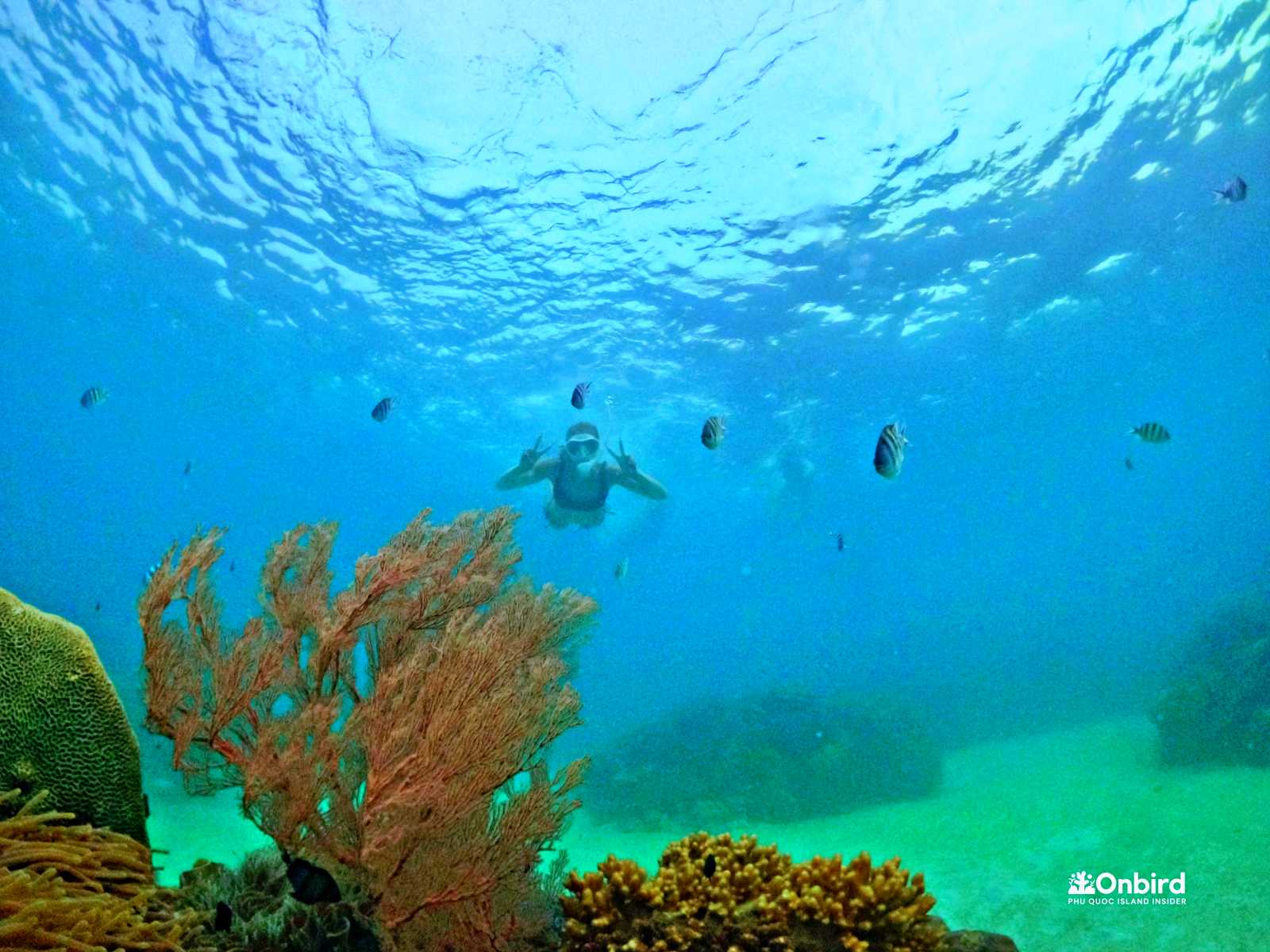
Dựa trên quan sát các khảo sát thực tế, chúng tôi quan sát được là độ sâu phổ biển mà các loài san hô Phú Quốc phát triển mạnh nhất là trong khoảng 1 – 6 mét sâu, đặc biệt nhóm san hô bàn (Table Coral hay Acropora) là nhóm phát triển mạnh mẽ nhất cùng với các loài san hô Nút (Button Coral hay Zoanthids), san hô Súp lơ (Cauliflower coral) và san hô Lá (Leaf coral) chiếm một phần lớn diện tích tại các Rạn san hô. Tại một số Rạn san hô của Phú Quốc có thể thấy những khối san hô Bàn với đường kính 2 – 7 mét. Đặc biệt Nam đảo Phú Quốc là nơi có độ đa dạng cũng như mật độ san hô cao và dày đặc hơn so với khu vực Bắc đảo Phú Quốc.
Để có chuyến đi lặn biển Phú Quốc an toàn và lý tưởng mời các bạn đọc thêm chỉ dẫn toàn diện về thời tiết đảo Phú Quốc theo từng giai đoạn trong năm tại đây.
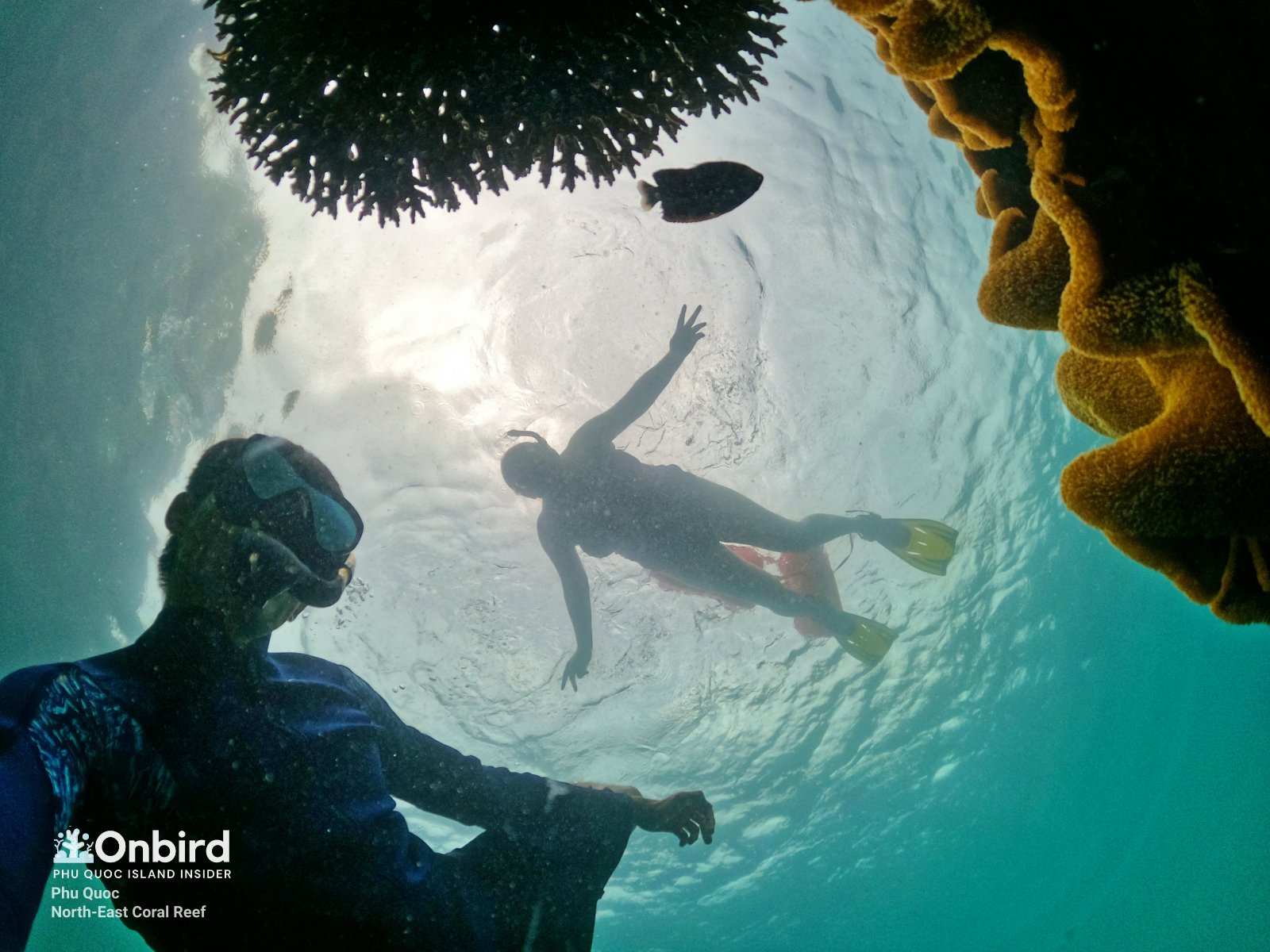
I. NAM ĐẢO PHÚ QUỐC
1. Núi San Hô Phú Quốc (Coral Mountain):
- Loài san hô: San hô Xương Rồng (Pavona Coral), San Hô Nút (Button Polys hay Zoanthids)
- Độ sâu: 0.5 – 3m
- Loại rạn san hô: Rạn gần bờ (Nearshore Reef)
- Loại hình khám phá phù hợp: Lặn ống thở (Snorkeling) – Try-dive (thử lặn bình khí)
- Tình trạng Rạn san hô: Tình trạng phát triển tốt, san hô sống, có một số chỗ bị xâm hại bởi du khách. Khu vực san hô xung quanh chết nhiều hoặc bị xâm hại nghiêm trọng
- Thời gian khám phá thích hợp: gần như quanh năm
Núi San Hô Phú Quốc (Coral Mountain) là rạn san hô Xương Rồng (Cactus/Pavona Coral) lớn nhất Phú Quốc với diện tích lên tới 200 – 300 mét vuông. Phát triển trong một vùng nước nông với độ sâu chỉ 0.5 m – 3 m, nơi có độ trong thuộc nhóm tốt nhất Phú Quốc nên Rạn san hô Xương rồng này đã phát triển với kích cỡ khổng lồ. Chiều cao của Núi San Hô vào khoảng 2.5 m – 3 m trong đó phần đỉnh của Núi San Hô cách mặt nước 0.2 – 0.5m tùy vào mức thủy triều của nước, những ngày triều thấp có thể để lộ phần đỉnh khỏi mặt nước.
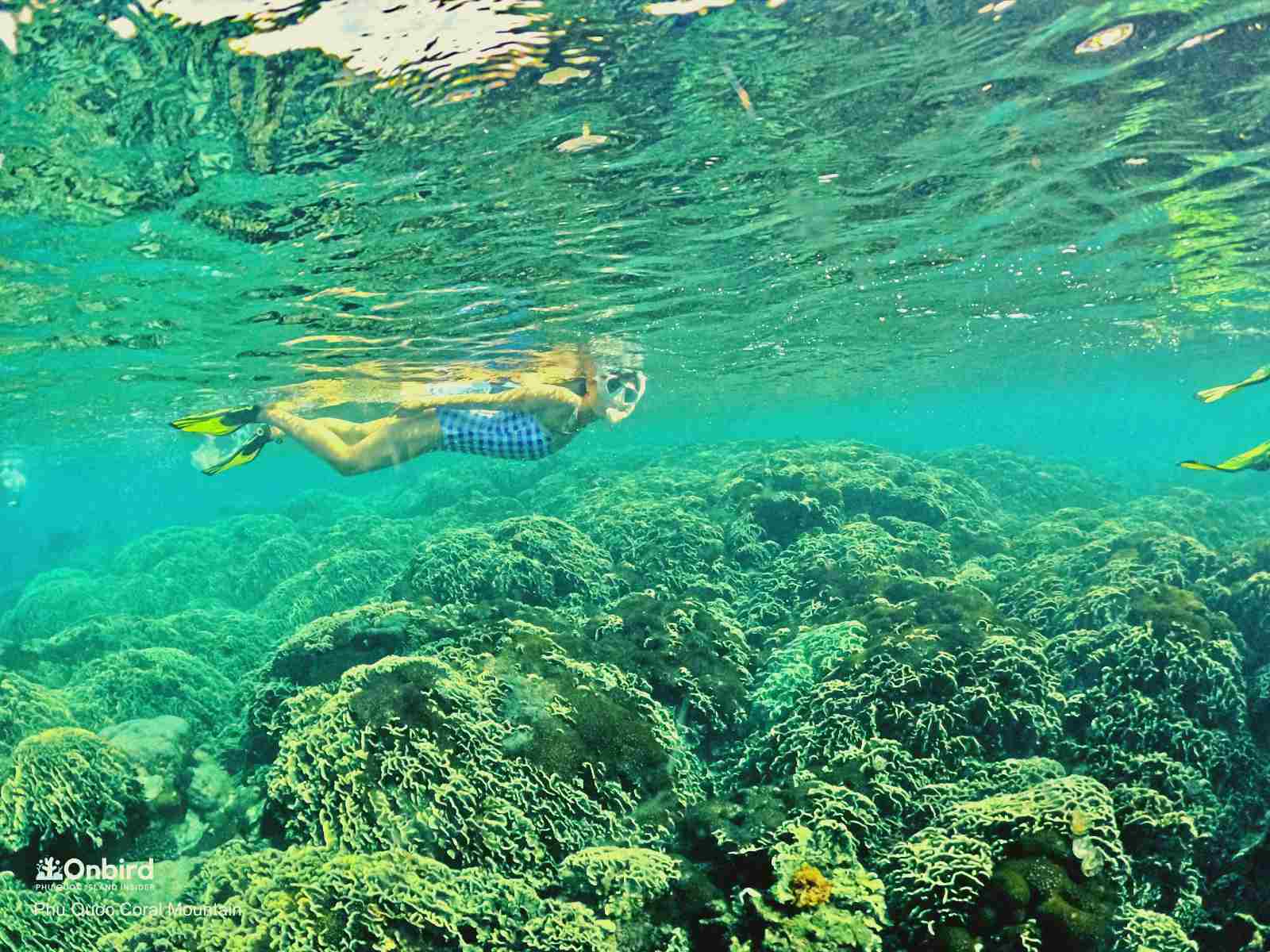
Núi San Hô Phú Quốc chia làm 2 phần chính với một rãnh nhỏ ở phần giữa, màu sắc chủ đạo là màu xanh lục cũng là màu đặc trưng của các loại san hô thuộc nhóm Pavona (lá, xương rồng, đĩa), các khóm san hô Xương Rồng mọc liên kết với nhau liền mạch tạo nên một kỳ quan dưới nước với tạo hình giống một dãy núi. Khu vực Núi San Hô được bao bọc xung quanh bởi các khóm san hô Lá và san hô Khối (Porite Coral)
Tùy từng thời điểm biển động các đàn cá con sẽ về khu vực Núi San Hô để trú tạo ra cảnh tưởng hết sức sống động với hàng trăm ngàn con cá con bơi núp trong Núi San Hô. Trên bề mặt Núi San Hô cũng có những con Sâu Vũ Công hay Sâu bông thụt (Feather duster worm) trú ngụ với các xúc tu vươn ra như các bông hoa nhỏ.
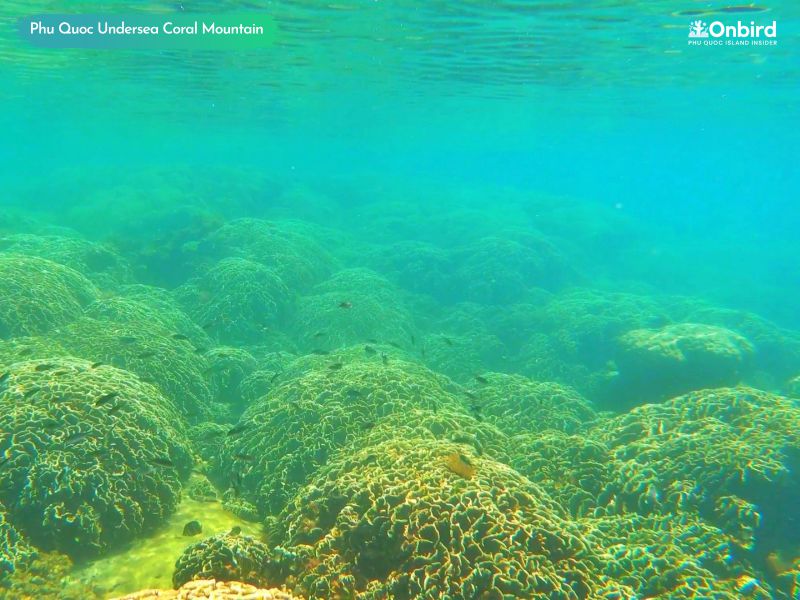
OnBird khám phá Núi San Hô Phú Quốc lần đầu vào năm 2018 sau các chuyến lặn khảo sát, khá thất vọng với việc 80-85% rạn san hô xung quanh khu vực Núi San Hô bị chết hoặc tổn hại nghiệm trọng, chúng tôi rất vui mừng khi phát hiện ra Núi San Hô, là khóm san hô lớn nhất với tình trạng sức khỏe san hô rất tốt do được bao quanh bởi các khối san hô đá và vị trí khó tiếp cận. Tuy nhiên, theo quan sát mới nhất 15/7/2022 sau 4 ngày chịu ảnh hưởng áp thấp nhiệt đới, biển động mạnh, chúng tôi phát hiện 1 phần Núi San Hô bị tổn hại khá nặng nề với các tảng san hô bị gãy toác ra, nghi do bị tàu cá ngư dân hoặc cano hoặc vật thể nào đó tác động rất mạnh. Chúng tôi vẫn đang tiếp tục theo dõi thêm khả năng phục hồi rạn tại đây.
But fortunately, after many times of exploring here we found out the biggiest Cactus coral (Pavona Cactus) colony that we name it as “Undersea Coral Mountain”, which is still healthy and alive. Which make us feeling happy after getting very disappointed with the bad situation of corals at Phu Quoc Crystal Reef. Especially, the Button Polyps Corals that live interspersed among the Cactus corals making amazing moments, when you wave slightly the Button corals they will retreat their tentacles, creating effects like color change on corals but sadly the Button Polyps Corals are invading and blanketing the Coral Mountain gradually thereby we are having to act to stop their invasion.
Video quay một chú sên biển đang bơi gần Núi San Hô được OnBird ghi lại trong chuyến lặn ống thở (snorkeling)
2. Coral Hill: The Phu Quoc’s second largest Flowerpot Coral Cluster in Phu Quoc
Coral Hill is a huge Flowerpot coral (Goniopora) cluster located in South Phu Quoc Island which is the Phu Quoc’s second largest flowerpot coral cluster that OnBird has ever observed. Flowerpot coral is known as Goniopora stokesi is ball shaped with very long tentacles, is a genus of colonial stony coral found in lagoons and turbid water conditions. Flowerpot corals have numerous daisy-like polyps that extend outward from the base, each tipped with 24 stinging tentacles which surrounds a mouth.
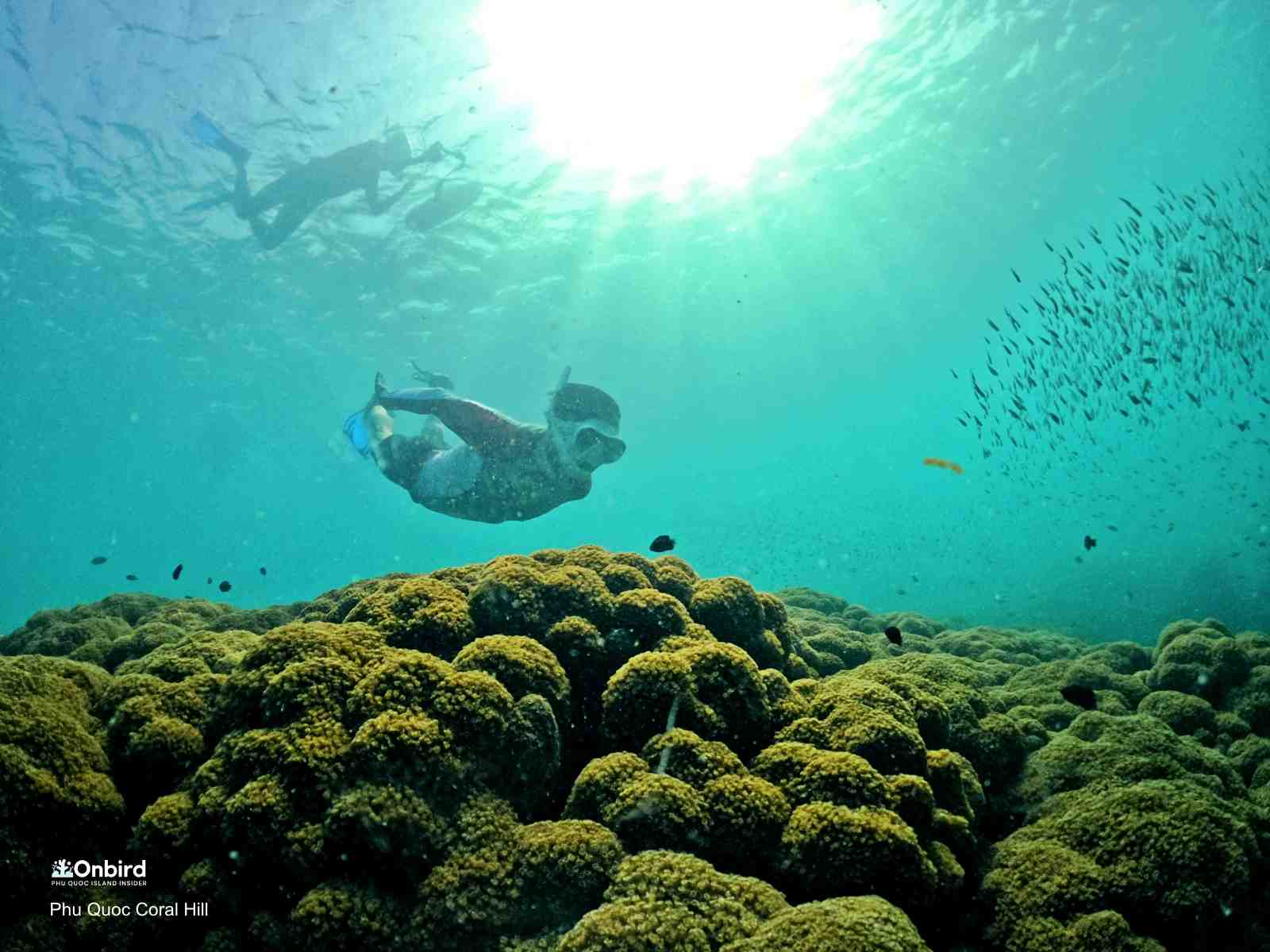
This flowerpot coral cluster has been growing into a huge size with a hill-like outward appearance. We estimate that the area of this flowerpot coral cluster is around 40 – 45 sq meter which is much more smaller than the Coral Mountain (the largest cactus coral colony in Phu Quoc). Depth ranges to explore the Coral Hill is 3 – 6m, very ideal depth to try skindiving.
3. Rạn San Hô Bán Nguyệt (Half-moon Reef)
- Loài san hô (với khoảng 20 loại san hô): san hô Xương Rồng, san hô Lá, san hô Bàn, san hô Súp lơ, san hô Đĩa, san hô Nấm, san hô Cột đĩa, san hô Cột, san hô Ngón tay, san hô Da Cóc, san hô Đá Ụ, san hô Tổ Ong, san hô Xà lách, san hô Lọ Hoa, san hô Cốc cam, san hô Não, san hô Sừng, Bọt biển khổng lồ, san hô Bụi, Hải Quỳ…san hô Lá, san hô Đĩa, san hô Ngón Tay, san hô Cột, san hô Súp lơ, san hô Bàn, Hải Quỳ…
- Độ sâu: 0.5 – 10 m
- Loại rạn san hô: rạn viền bờ (Fringing coral reef)
- Loại hình khám phá phù hợp: Lặn ống thở (Snorkeling) – Lặn bình khí (Scuba Diving) (Fun-dive)
- Tình trạng Rạn san hô: độ đa dạng cao, san hô sống có tình trạng sức khỏe tốt tuy nhiên gần bờ một số khóm san hô đã bị gẫy chết (cập nhật 07/2022) do neo cano của các tour đảo phục vụ chụp hình SUP hoặc các tour lặn ngắm san hô không chuyên. Đặc biệt phát hiện việc cắt một số loài san hô với các vết tích còn lại và so sánh ảnh chụp cùng vị trí trước đó
- Thời gian khám phá thích hợp: giai đoạn mùa khô từ tháng 10 tới tháng 4, một số khoảng thời gian giữa tháng 5 và tháng 8
Video quay lại cảnh lặn ống thở tại rạn san hô Bán Nguyệt, Phú Quốc vào năm 2022 của OnBird
Rạn san hô Bán Nguyệt là một trong những lựa chọn hàng đầu tại Phú Quốc và Việt Nam cho cả các trải nghiệm lặn ống thở (snorkeling) và lặn bình khí (scuba diving). Đây là một trong những Rạn san hô có độ đa dạng loài san hô cao và mật độ san hô dày đặc bậc nhất tại vùng biển Phú Quốc với trên 20 loài san hô khác nhau. Với địa hình gồm các vách đá, khe đá hẹp lớn dưới nước được che phủ hoàn toàn bởi các loại san hô, cùng các khối san hô đá, san hô Tổ Ong khổng lồ giúp tạo nên cảnh quan hết sức sống động và kỳ bí dưới nước cho những ai ưa khám phá.
* Vườn Cá Hề – Hải quỳ
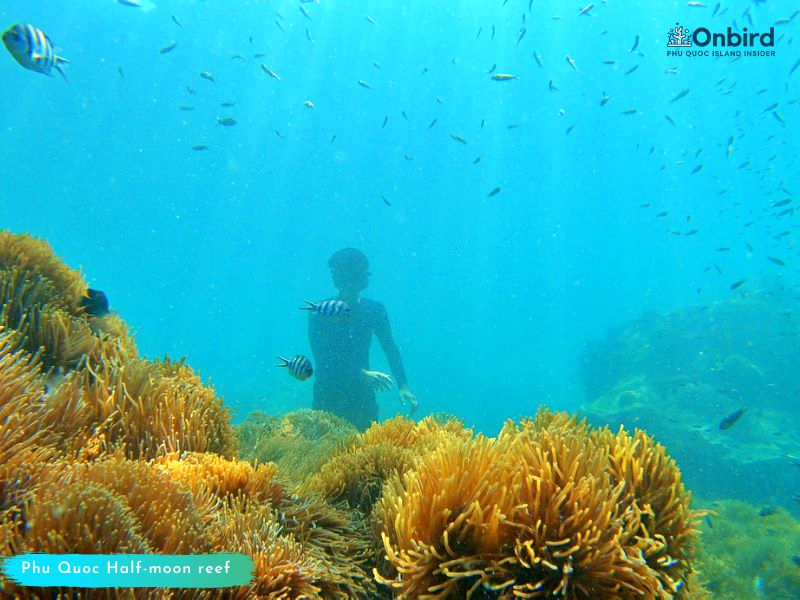
Vườn Cá hề – hải quỳ lớn nằm ở độ sâu 4 – 5m bao phủ một diện tích khoảng 8-10 m vuông, đây là một trong những quần thể hải quỳ lớn nhất tại Phú Quốc, có thể tìm thấy các quần thể tương tự hoặc lớn hơn tại rạn san hô Đông Bắc. Thuộc giống họ hải quỳ Heteractis magnifica, thân hình trụ, màu tím, hút chặt gắn lên một khối san hô đá Porite Coral. Hải quỳ có màu nâu sẫm, ánh sáng chiếu sẽ lên màu vàng, một số khóm trong rạn có màu xanh lục mờ đây là loài hải quỳ phổ biến tại Phú Quốc. Loài cá hề sống cùng hải quỳ là cá hề cam cam hay Pink Skunk clownfish. Bao bọc xung quanh là các khóm san hô cứng khác nhau. Lặn xuống và nhìn cận cảnh giống như đang bơi qua một vườn hải quỳ. Ngoài ra tại Rạn san hô Bán Nguyệt còn có những khóm hải quỳ cỡ lớn khác nằm ở độ sâu 6-7 m.
* Phu Quoc Finger Coral-Covered Rock
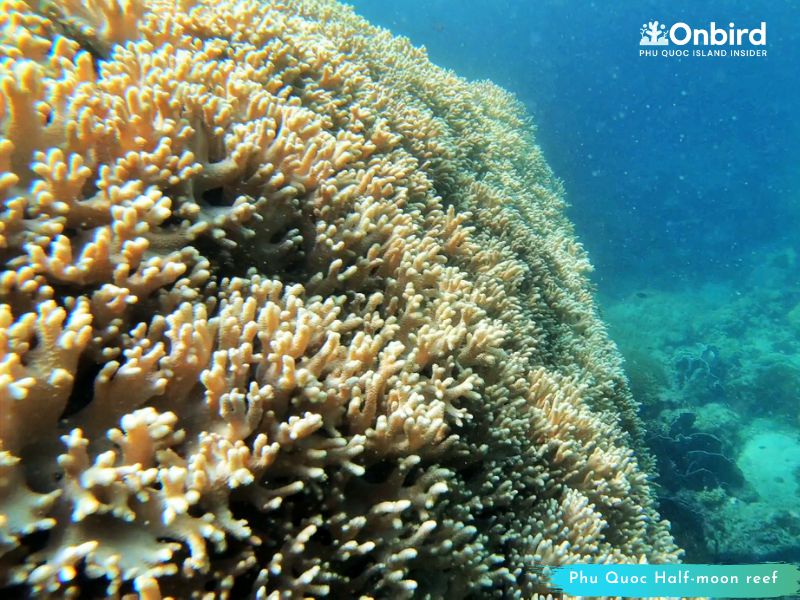
Located at the depth of 6 meters with 4 meters long and 2 meters high, this is an amazing ideal spot for either snorkeling or free-diving, this Finger coral-covered rock located close to a big rock make a small cliff between. Finger coral or Sinularia Levi coral is a one of 2 most popular soft coral species in Phu Quoc. Enjoy a fascinating feeling of swiming, snorkeling, diving along the cliff with plenty of coral covering. The close view is totally different from above, look shimmering, magical. Around the cliff are anemones, leaf corals and giant tube sponges.
In the video below there is a section of the Finger coral-covered cliff (103s) we recorded in Phu Quoc Half-moon Reef
* Phu Quoc Golden Toadstool Coral-covered Canyon
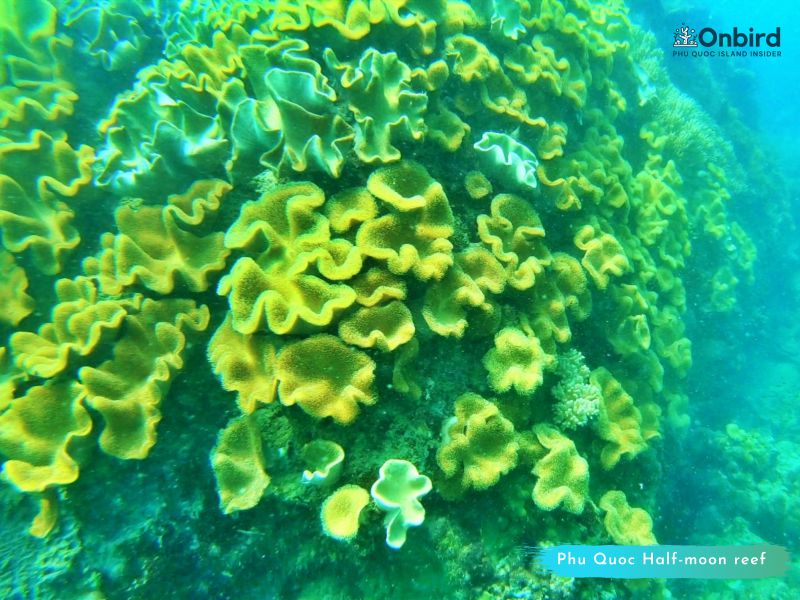
In Half-moon Reef, we find interesting ridges of jagged material below the surface. Toadstool coral-covered Canyons are around 5 – 6 m long and 5 – 7m deep and almost 3 m in height, completely covered by Toadstool Coral (a common soft coral in Phu Quoc). Live interspered with toadstool corals or capret corals are brain corals and finger coral on the seabed surface you will be seeing the presence of Montipora Monasteriata Corals and Brain Corals… We find that the toadstool corals in Half-moon reef in particular and whole Phu Quoc in gerneral will get bleaching seasonal, sometime toadstool coral get white completely and then few days or a week later the tentacle start to extend and change the coral into yellow.
* Phu Quoc Coral Continental Slope
The slope is at the depth of 4 – 5m, it is about 5 – 6 m long, an amazing spot to view the corals from an incredible new perspective underwater. The slope is fullly covered by plate and pillar corals, a big colony of giant tube sponge and anemone make the spot charming when looking up from below.
* Phu Quoc largest Dome-shaped Honeycomb Coral
A 5 – 6-meter-wide Honeycomb Coral discovered at the depth of 7 meter of Phu Quoc Half-moon Reef, with a height of 3 – 4 meter from the foot to the head. This honeycomb coral is the widest we have ever found in the Phu Quoc water. On top of that, the Honeycomb coral has a twin brother which is smaller in size.

* Phu Quoc Lettuce Coral garden
This is the largest lettuce coral colony we have found in Phu Quoc Island, located at the depth of 2.5 – 4m in Phu Quoc Half-moon Reef. We document the lettuce coral garden in April 2022 for the first time, corals are healthy. Growth right at the shore the the colony is easily damaged by irresponsible speedboats if they drop down the anchors on.

Check out professional snorkeling tours by OnBird: Private tour or Small-group tour (Max 6 – 8 Pax) with underwater guides to explore this beautiful coral reef of Phu Quoc Island.
In the Phu Quoc Half-moon Reef, we can also observe an uncomon soft coral in Phu Quoc is Finger Leather Coral(Sinularia or Nepthea Coral), it is usually found at the depth of more than 8 – 12 m but we found somes at the depth of around 4 – 5m.
4. Shallow Reef: the kingdom of big-sized Table Corals in Phu Quoc Island
- Coral Species (around 12 different speices of corals): Table coral, Leaf coral, Cauliflower coral, Plate coral, Mushroom coral, Toadstool coral, Pore Coral, Button coral, Brain coral, Staghorn coral, Octopus coral, Anemone…
- Depth range: 0.3 – 6m
- Type of coral reef: Fringing Reef
- Proper diving experience: Snorkeling – Try-dive (Scuba Diving)
- Coral health status: both live and dead corals, some biggest table coral colonies were damaged by anchor of speedboats recently
- Exploring time: in the summer or Rainy Season (May – October) or even November
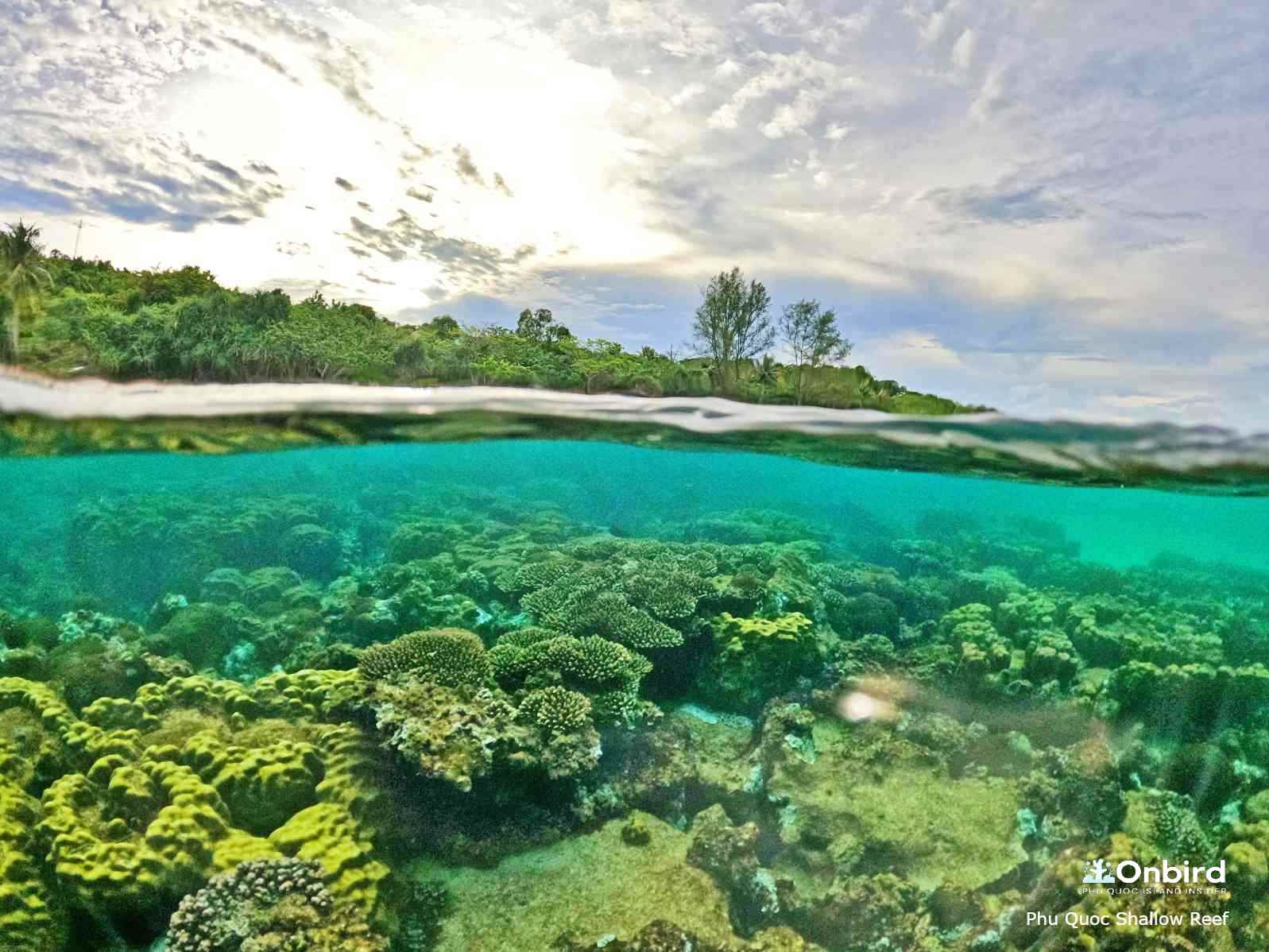
This is truly home to Table corals acrross whole Phu Quoc Island, you dont find here a great variety of coral species with just only around 12 different coral species among that, the reef is dominated by table corals the most. Thanks to the shallow water that Table corals here have been growing into very large in size. We found here largest table coral colony of Phu Quoc Island, Vietnam with 7 – 8 m arross and 1.5 m high separated into 3 – 4 floor. Please see the photos below of the largest table coral colony ever found in Phu Quoc Island.
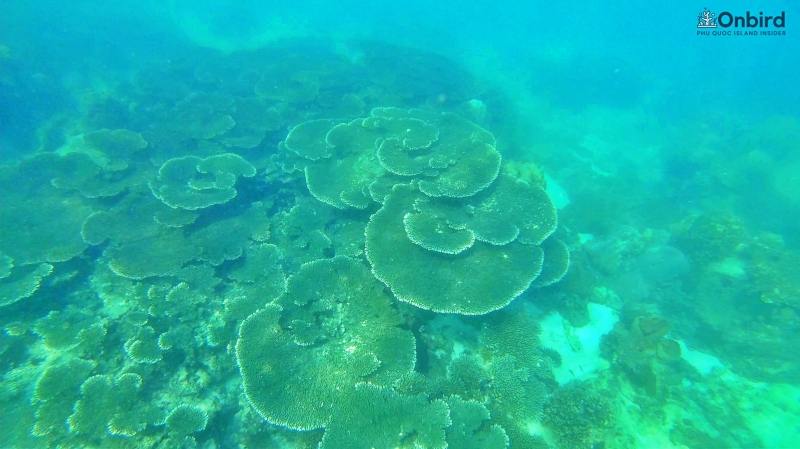
The largest table coral colony growths into a flower-shaped colony, with the foot located at the depth of 4 – 5m.
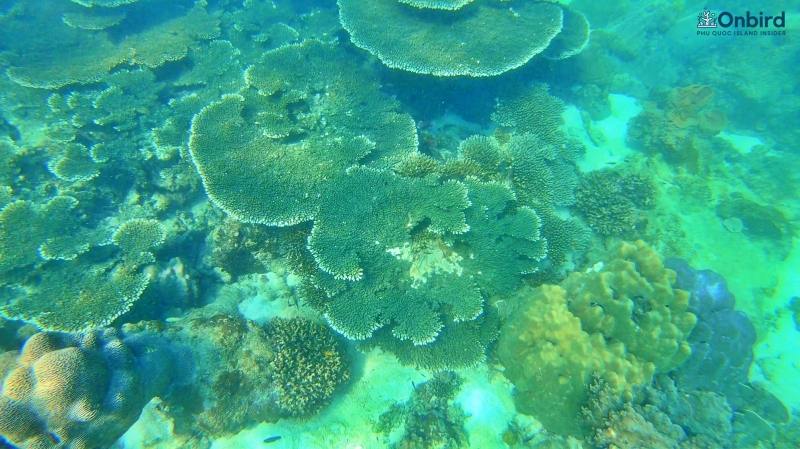
To explore the Phu Quoc Shallow reef, a skilful snorkeling skill is a must, as you might get stuck and damage table corals when getting closer to the shore at where the depth is only 0.3 – 0.4m. Toadstool corals located close to the shore at the depth of just 1m.
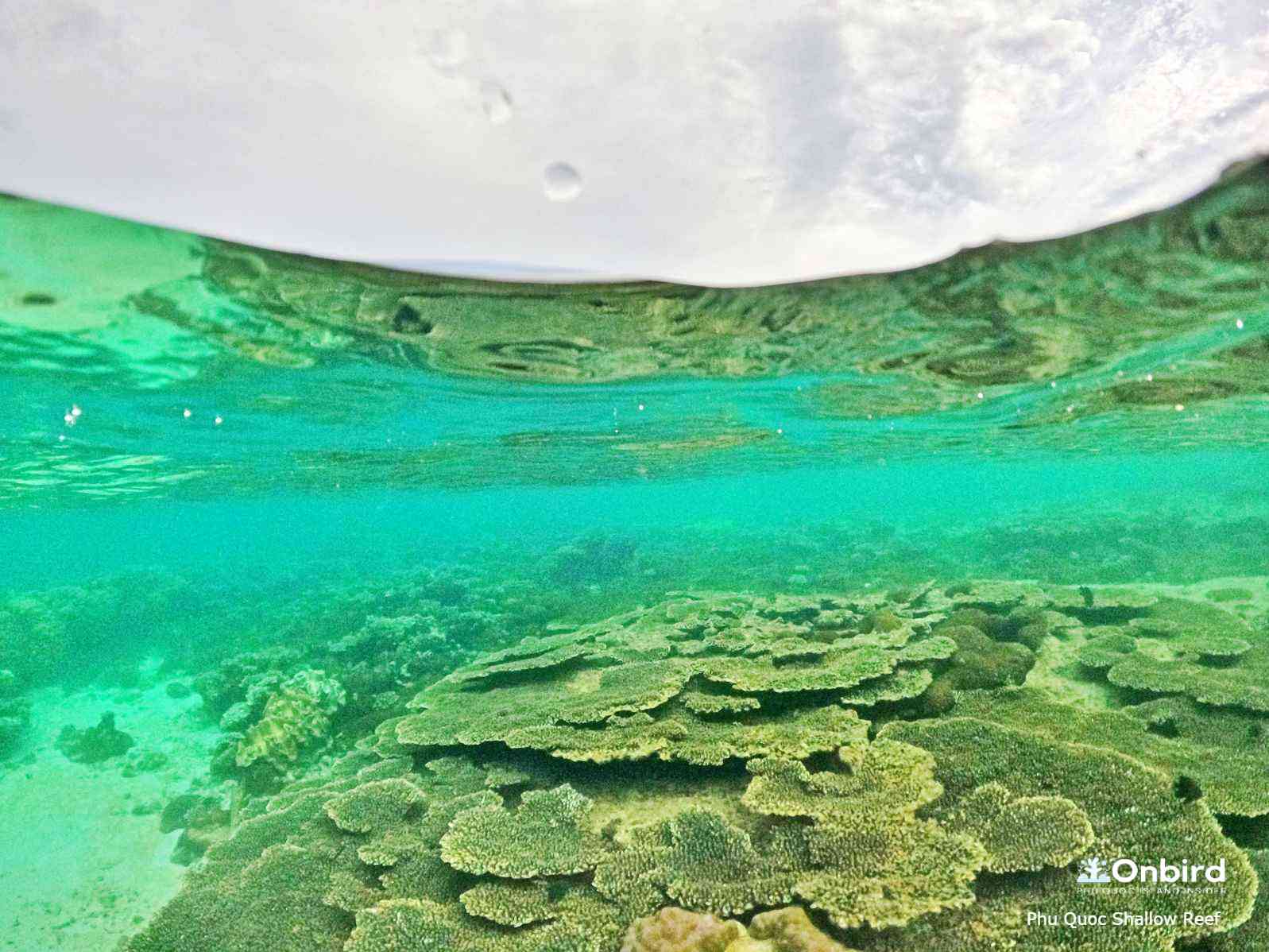
Table corals live on pore corals and stony coral species
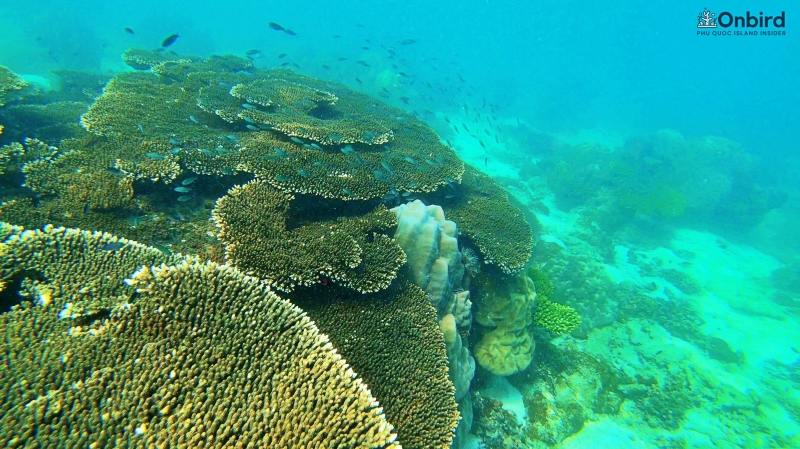
Video of snorkeling and corals in Phu Quoc Shallow Reef
However the reef is now under serious threat by speed boats as we found the largest table coral colony aforementioned damaged 80%. Besides that we find here many “ghost nets” left by fishermen and brought here by the waves, we sometimes make clean up snorkeling trip to clean “ghost nets” in Phu Quoc but we still find them sometime.
5. Coral Steep: A coral garden in South Phu Quoc
- Coral Species (around 12 different speices of corals): Table coral, Cactus coral, Plate coral, Cauliflower coral, Mushroom coral, Pore Coral, Button coral, Brain coral, Orange Cup coral, Giant tube sponge, Starghorn coral, Flowerspot coral, Anemone…
- Depth range: 0.5 – 8 m
- Type of coral reef: Fringing Reef
- Proper diving experience: Snorkeling – Try-dive – Fundive (Scuba Diving)
- Coral health status: both live and dead corals, a large cactus coral grove was damaged by anchor of speedboats recently (updated on 15/7/2022)
- Exploring time: All year around
The terrain is gently sloping coral with a depth of 0.5 – 8m, in which coral grows strongly in the range of 0.5 – 3.5m. The main group of coral species are Porite Corals, Table corals, Cactus corals and Cauliflower corals. This is one of the fringing reefs still preserve it’s pristine beauty and easy to explore for snorkelers (snorkeling). It can be likened to a miniature coral garden, although not too diverse in coral species, corals grow densely to form a large coral carpet. Cauliflower coral here is quite special when mostly purple cauliflower coral.
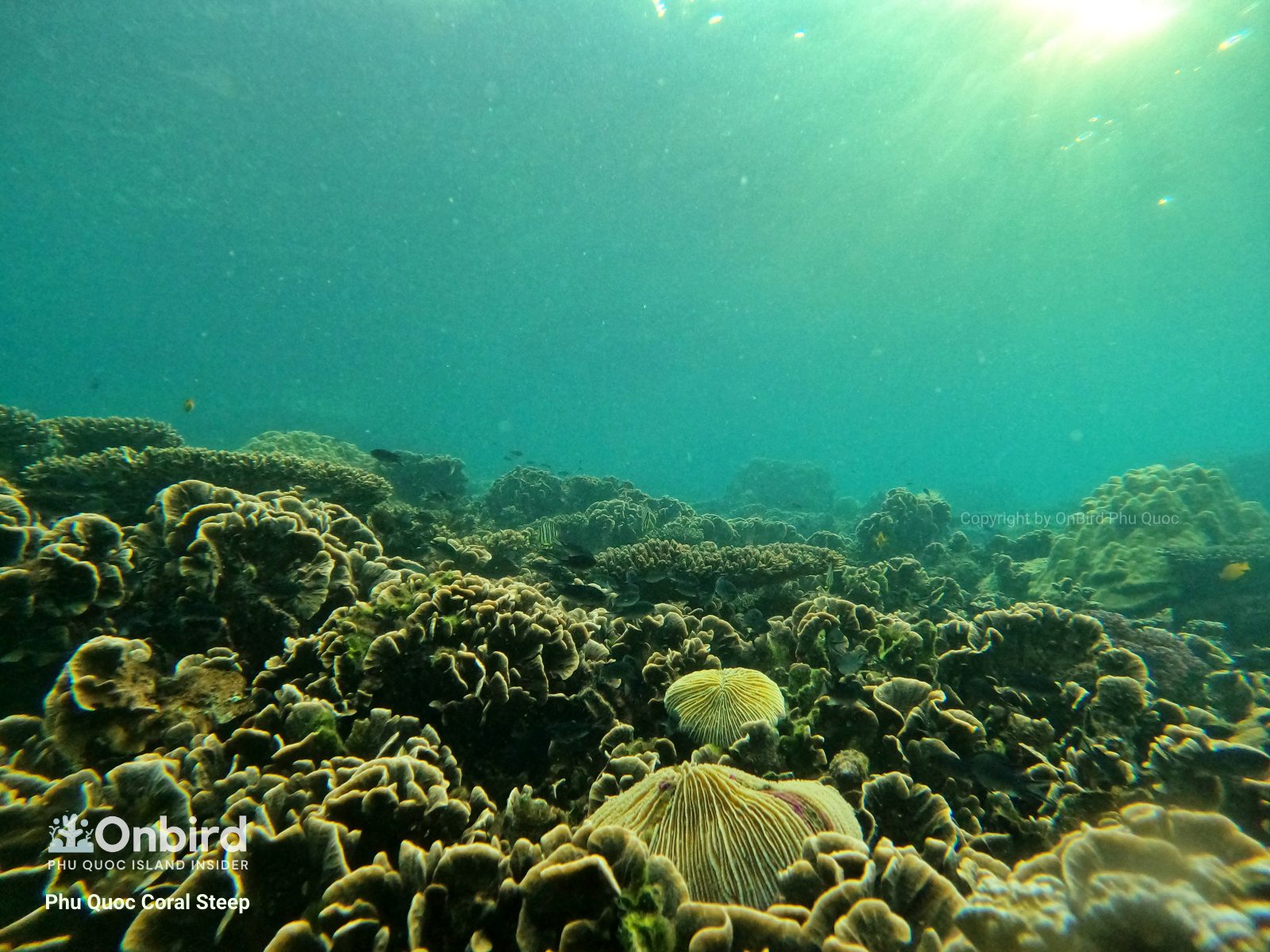
At a depth of 1-1.5m, large populations of table corals with coral diameters up to 1.5m are formed. Coral grows densely in the depth of 0.5 – 3m. The snorkeling experience here is like walking in a small garden, the coral color is quite fresh, updated to July 10, 2022, the coral here is hardly affected by humans compared to other places. other coral reefs in Phu Quoc due to being surrounded by large coral reefs.
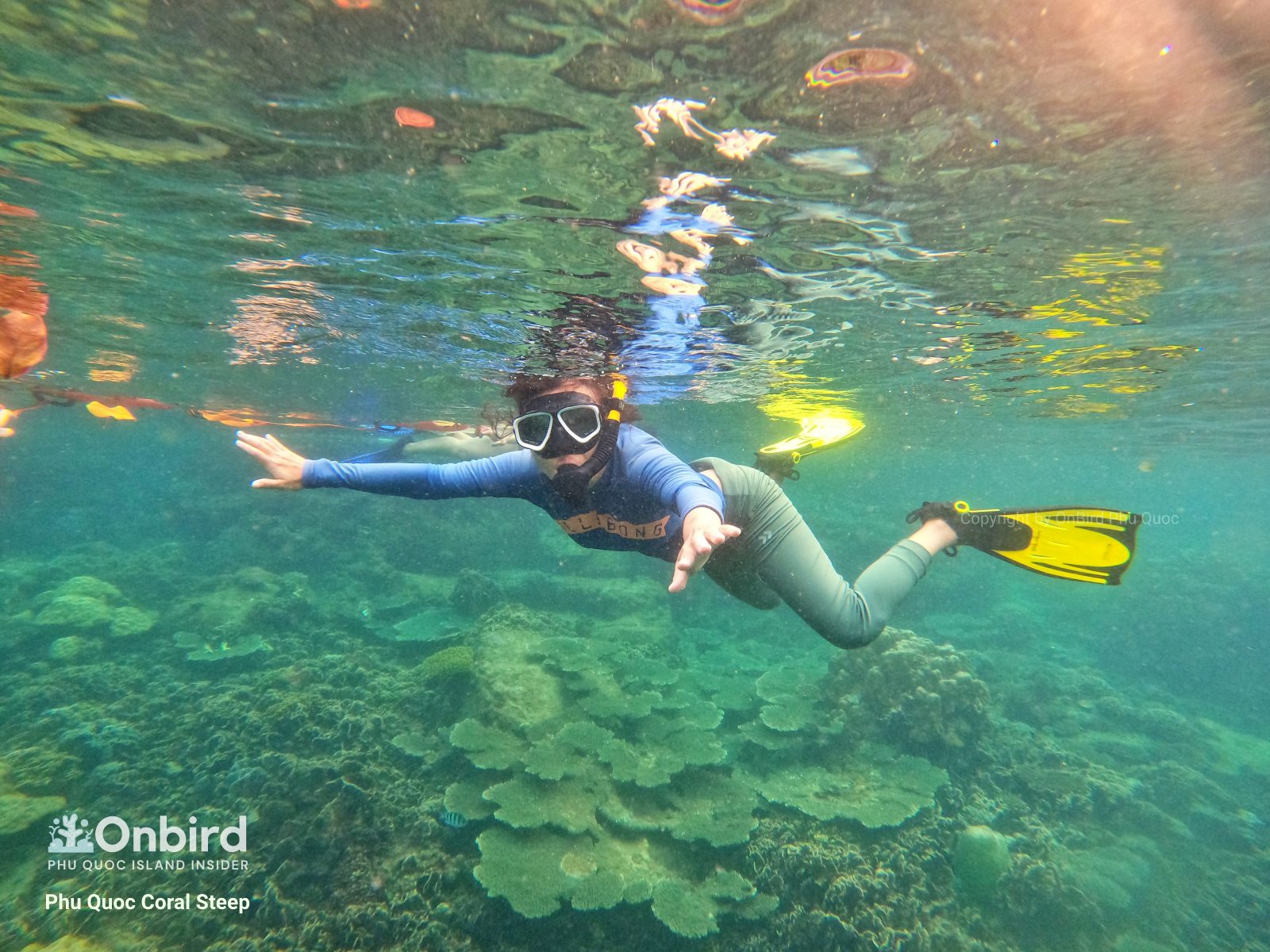
At a depth of 1-1.5m, large populations of table corals with coral diameters up to 1.5m are formed. Coral grows densely in the depth of 0.5 – 3m. The snorkeling experience here is like walking in a small garden, the coral color is quite fresh, updated to July 10, 2022, the coral here is hardly affected by humans compared to other places, other coral reefs in Phu Quoc thank to being surrounded by large massive corals.
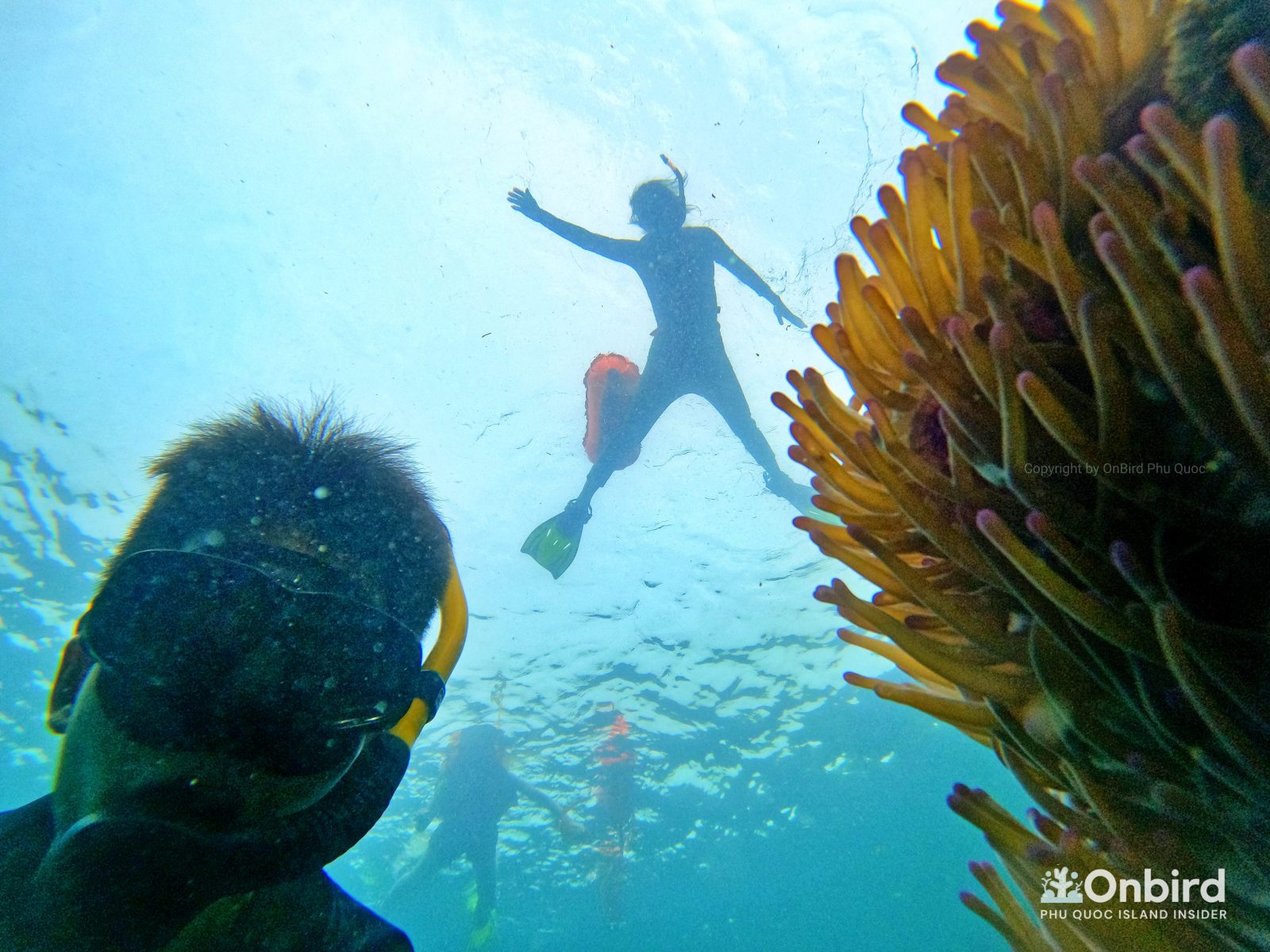
We find here only one small anemone across whole the Coral Steep.
However: latest update on 15/7/2022 we are shocked to see a heavy damage on the cactus coral colony and cauliflower at the Coral Steep. We found the same situation at Coral Mountain at the same time. We are not sure what cause the terrible damage on the corals but it must be strong as we saw even some stony corals found in an overturned state and broken in half.
6. U-Turn: A small bay for Snorkeling and Scuba Diving in Phu Quoc Island
- Coral Species (around 13 – 14 different speices of corals): Table coral, Leaf coral, Cauliflower coral, Plate coral, Mushroom coral, Toadstool coral, Pore Coral, Button coral, Brain coral, Giant tube sponge, Anemone…
- Depth range: 0.5 – 12 m
- Type of coral reef: Non-fringing Reef
- Proper diving experience: Snorkeling – Try-dive – Fundive (Scuba Diving)
- Coral health status: both live and dead corals, some biggest table coral colonies were damaged by anchor of speedboats recently
- Exploring time: in the Drys season (October – April)
Phu Quoc U-Turn is another good choice for people who are keen on free-diving as well as snorkeling. The coral populations here are not large and not as dense as Half-moon Reef, North-east Coral Reef. The average depth here is deeper than Half-moon Reef and North-east Coral Reef, average depth is about 4 – 6m. If you are not used to the sea then U-Turn will scare you as the reef is to drop down 12 – 13m suddenly in certain places.
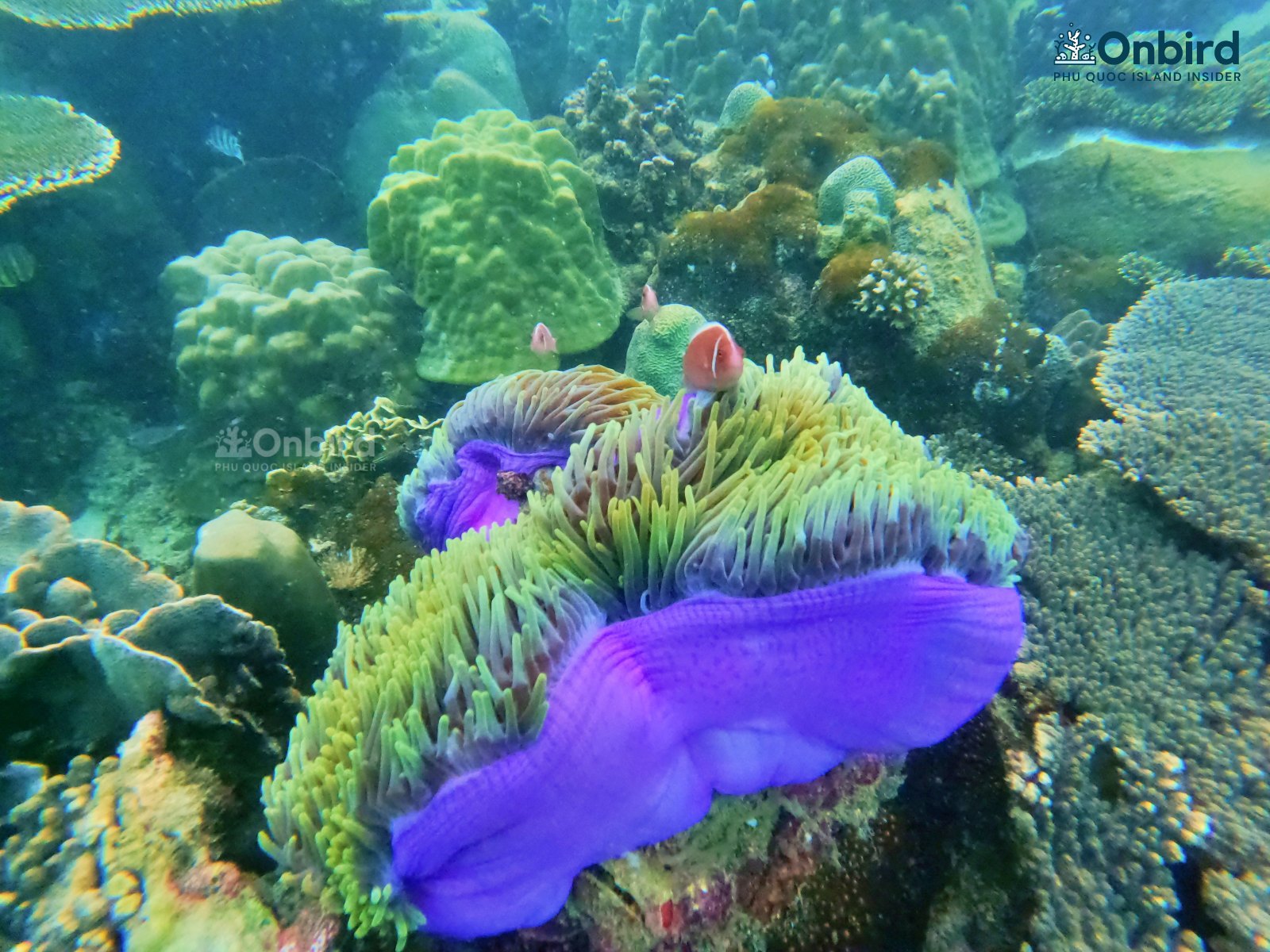
For snorkeling you could do near to the shore and for scuba diving just need to descend down and get further a little bit from the shore to reach the depth of 12 m. You dont see here many anemones and finger corals like Half-moon Reef, but it is great to dive in a vast seabed right at the foot of the shore.
The photos below are a giant clam that you will be able to see when proceeding snorkeling at U-Turn and Half-moon coral reef
7. Rạn san hô Đông Bắc: thành phố san hô Nam đảo Phú Quốc
- Loài san hô đặc trưng (khoảng 22 loài): San hô ngón tay, san hô da cóc, san hô lọ hoa, san hô cột, san hô súp lơ, san hô cột đĩa, san hô cốc cam, san hô xà lách, san hô bàn, san hô não, san hô đá, san hô nấm, san hô bụi, san hô sừng huơu, san hô lá đĩa, san hô lỗ, san hô xương rồng, san hô lá, san hô nút, san hô quạt, ống bọt biển…hải quỳ
- Dải độ sâu: 0.5 – 9 m – 16 m
- Loại rạn san hô: Rạn viền bờ không điển hình (Non-Fringing Reef)
- Loại hình khám phá phù hợp: Lặn ống thở (Snorkeling) – Lặn bình khí (bao gồm Try-dive – Fundive)
- Tình trạng san hô: san hô sống chiếm tỷ lệ 99%, không có dấu hiệu suy thoái
- Thời gian khám phá thích hợp: Mùa hè (Mùa mưa Phú Quốc), một số thời điểm mùa khô có thể khám phá
Được mệnh danh là thành phố san hô, Rạn san hô Đông Bắc là một trong những Rạn san hô đẹp nhất Phú Quốc, Việt Nam. Nằm cách đảo Phú Quốc 16 km về hướng Nam, Rạn san hô Đông Bắc là một trong những Rạn san hô khó tiếp cận nhất tại Phú Quốc trong một năm do vị trí địa lý thường xuyên chịu ảnh hưởng của các dòng nước chảy và gió mùa tạo sóng động nên cần theo sát kỹ các điều kiện nước mới để xác định khung thời gian an toàn để đến Rạn san hô này.
Northeast Reef is a kind of coral field with a great diversify of coral species, the reef depth ranges from 1 – 9m, go further to outer reef it could descende down 16m, the coral reef develops hunderus meters along the foot of an island, at Phu Quoc Northeast Reef you could find anemone gardens at the depth of 1.5 – 5m and big table corals with diameter of 3m…
We have found the existence of 20 coral species there. Due to the special location it is not easy to reach the coral reef as the water is usually wavy and strong current thereby we always check the water conditions to find dates and proper timeframe to explore this coral reef. Besides that this coral reef is also the best choice for snorkeling in the rainy season (summer time) in Phu Quoc island, a good place to enjoy drift snorkeling in Phu Quoc Island.
A video recorded by our guests on their snorkeling and scuba-diving trip to Phu Quoc Northeast Coral Reef
Make referrence to our snorkeling trips in Phu Quoc Island for the summer and rainy season
II. North Phu Quoc Island, Vietnam: Snorkeling and Diving Report
Not like the South of Phu Quoc Island, in the North there are less coral spots to explore. However the coral reefs in North Phu Quoc Island are less spoiled, less vulnerable than South Phu Quoc Island.
1. CORAL JUNGLE REEF: DECENT & THE HEALTHIEST CORAL REEF IN PHU QUOC
- Coral Species (around 19 – 20 different speices of corals): Cactus Coral, Leaf coral, Table coral gardens, Cauliflower coral gardens, Plate coral, Mushroom coral, Plate and Pillar coral, Pillar coral, Finger coral, Toadstool coral, Pore Coral, Flowerpot coral, Orange cup coral, Button coral, Fan coral, Brain coral, Giant tube sponge, Big Yellow Rope sponge, Staghorn coral, Anemone…
- Depth range: 0.5 – 9 m – 9 m
- Coverage of coral: 80 – 82.5%
- Type of coral reef: Fringing Reef
- Proper diving experience: Snorkeling – Scuba Diving (either Fun-dive and Try-dive) – Free-diving
- Coral health status: live coral, some closeshore spots are damaged by anchor of speedboats recently, some corals are cutted to be taken to bring to sea-walking clubs in Phu Quoc
- Exploring time: in the dry season (October – April), the best coral reef for diving & snorkeling in whole Vietnam during December and January
Coral Jungle is the healthiest coral reef in Phu Quoc Island with a extremely high coverage of coral up to 82.5%. If you want to immerse into the world of coral, this is the top choices in Phu Quoc, very different from coral view in Southern Phu Quoc Island coral reefs. This is the best coral reef for diving & snorkeling during December and January in Phu Quoc in terms of water conditions and biodiversity.
Alive corals account for 99% at the Coral Jungle Reef, the reason is that there are usually strong current here which prevent most of people to reach the reefs and help to spread coral eggs easier and stronger to build the reef. Need to very high accuracy water condition tracker to find the good time to visit here. Make refference to our soft-adventure small-group snorkeling trip (max 6 – 8 PAX) by speedboat or a Private Snorkeling Trip by speedboat to explore the Coral Jungle, Phu Quoc and sunset in North Phu Quoc.
2. Border Reef: An amazing reef in North Phu Quoc
3. Nudibranch Garden: A spot for macro diving
III. CORAL REEFS IN PHU QUOC ARE UNDER EXTREME THREATS
Coral Reefs in Phu Quoc are now invaded by “Sea Mats” or Button Polyps Coral in particular, Button Polyp Corals grow rapidly and will crowd out their neighbors including any sessile life, corals. Many of coral reefs in Phu Quoc now are being invaded up to 20 – 30% area.
INVASIVE CORALS ARE PUTTING PHU QUOC CORAL REEFS UNDER THREATS | FIGHTING HARMFUL CORALS
IV. WHEN IS THE BEST TIME TO SNORKELING & DIVING IN PHU QUOC ISLAND?
Insightful & reliable information about factors that impact on your snorkeling & diving experiences as well as clear the vague information about the best time to snorkeling and diving in Phu Quoc.
SCIENTIFIC SNORKELING: THE BEST TIME TO SNORKEL IN PHU QUOC ISLAND BY ONBIRD PHU QUOC

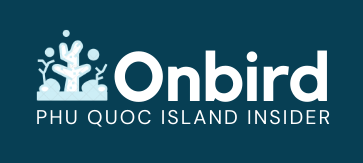

 English
English 日本語
日本語 中文
中文 한국어
한국어
